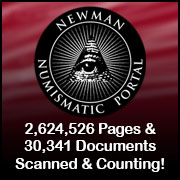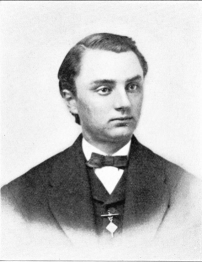
About UsThe Numismatic Bibliomania Society is a non-profit association devoted to the study and enjoyment of numismatic literature. For more information please see our web site at coinbooks.org SubscriptionsThose wishing to become new E-Sylum subscribers (or wishing to Unsubscribe) can go to the following web page link MembershipThere is a membership application available on the web site Membership Application To join, print the application and return it with your check to the address printed on the application. Print/Digital membership is $40 to addresses in the U.S., and $60 elsewhere. A digital-only membership is available for $25. For those without web access, write to: Charles Heck, Treasurer
AsylumFor Asylum mailing address changes and other membership questions, contact Chuck at this email address: treasurer@coinbooks.org SubmissionsTo submit items for publication in The E-Sylum, write to the Editor at this address: whomren@gmail.com BUY THE BOOK BEFORE THE COINSale Calendar |
- WAYNE'S WORDS: THE E-SYLUM MARCH 1, 2020
- NEW BOOK: 1ST ARMENIAN NUMISMATICS CONFERENCE
- NEW BOOK: OLD REGIME FRANCE AND ITS JETONS
- NEW BOOK: MEDALLIC HISTORY OF SLAVERY
- BANKNOTE BOOK MPC CHAPTER PUBLISHED
- AINA OFFERS DIGITAL AND PRINTED SHEKEL MAGAZINES
- VIDEO: U.S. MINT DIRECTOR EVA ADAMS
- VIDEO: "FOXY" STEINBERG INTERVIEW
- AMERICAN INSTITUTE OF PROFESSIONAL NUMISMATISTS
- NOTES FROM E-SYLUM READERS: MARCH 1, 2020
- MORE ON SOUTH WEST AFRICA CHITS
- THE NUMISMATIC MARKET AND THE STOCK MARKET
- VOCABULARY TERM: IMPRESSED ERROR
- HENRY CLAY MILLER (1844-1920)
- HARVEY STACK'S NUMISMATIC FAMILY, PART 64
- LONG BEACH ANTI-COUNTERFEITING SEMINAR REPORT
- ANS MONEY TALKS: BEFORE THE COINAGE ACT OF 1857
- ROCKWELL LECTURE: WOMEN, POWER, AND MAGIC
- CENTRAL STATES CONVENTION ANNOUNCES PROGRAMS
- FUND DRIVE: GET MR. LINCOLN TO THE PITTSBURGH ANA
- SHARJAH MUSEUM OF ISLAMIC CIVILIZATION
- MUSEUM OF INDIAN PAPER MONEY
- MORE ALBRIGHTON HOARD COINS FOUND
- GOLD COINS FOUND AT AT JAMBUKESWARAR TEMPLE
- NEW TREASURE COAST SILVER COIN FIND
- THE 'RICHMOND DOLLARS'
- THE CHAPMAN PROOF 1921 MORGAN DOLLAR
- DWIGHT MANLEY ACQUIRES BULK OF BAKER COLLECTION
- DIX NOONAN WEBB IRISH BANKNOTE SALE
- HIDDEN WORDS IN SEYCHELLES BANKNOTE DESIGNS
- MEXICO PLANS NEW 50-PESO BANKNOTE
- COLOR-CHANGING CRYSTAL VS. COUNTERFEITING
- CHINA'S BANKS DISINFECT OR DESTROY BANKNOTES
- VISITING THE MUTILATED CURRENCY DIVISION
- LOOSE CHANGE: MARCH 1, 2020
Click here to access the complete archive a
Click here to unsubscribe (scroll down)
To comment or submit articles, reply to whomren@gmail.com
Content presented in The E-Sylum is not necessarily researched or independently fact-checked, and views expressed do not necessarily represent those of the Numismatic Bibliomania Society.
WAYNE'S WORDS: THE E-SYLUM MARCH 1, 2020
 New subscribers this week include: Tony Antinoro. Welcome aboard! We now have 6,085 subscribers.
New subscribers this week include: Tony Antinoro. Welcome aboard! We now have 6,085 subscribers.
Thank you for reading The E-Sylum. If you enjoy it, please send me the email addresses of friends you think may enjoy it as well and I'll send them a subscription (but let me know if they are located in the European Union). Contact me at whomren@gmail.com anytime regarding your subscription, or questions, comments or suggestions about our content.
This week we open with four new books, a periodical offer, two new videos on the Newman Numismatic Portal, and notes from E-Sylum readers.
Other topics this week include the American Institute of Professional Numismatists, the numismatic market, impressed errors, author Henry Miller, multiple numismatic lectures and educational programs, two numismatic museums, three great coin finds, "Richmond Dollars", the Chapman Proof 1921 dollar, hidden words in banknote designs, and the Treasury's mutilated currency division.
To learn more about Armenian Numismatics, French jetons, slavery medals, Eva Adams, "Foxy" Steinberg, railroad medals, the Philadelphia Mint's Bicentennial exhibit, the the Sharjah Museum of Islamic Civilization, color-changing crystals and CSI: Currency Victims Unit, read on. Have a great week, everyone!
Wayne Homren
Editor, The E-Sylum
NEW BOOK: 1ST ARMENIAN NUMISMATICS CONFERENCE
Leon Saryan submitted this note on a book we haven't discussed before - the proceedings of the Armenian Numismatic First International Conference. Thanks. -Editor


On June 3-4, 2015, the Republic of Armenia National Academy of Sciences History Institute sponsored the Armenian Numismatic First International Conference, held in Yerevan at the Academy headquarters. The conference was dedicated to the memory of Khachatour Mousheghian (1919-1992), the first numismatic curator at the History Museum of Armenia. Mousheghian was a vigorous researcher and scholar who authored dozens of books and articles on various topics of Armenian numismatics. The conference was organized by his daughter Anahit Mousheghian, a researcher at the Academy, and in 2016 the proceedings of the conference were published. Due to unavoidable circumstances, my personal copy only reached me a few days ago.
The published proceedings comprise 430 pages on various topics of Armenian numismatics from pre-coinage times until the 20th century. Papers are in Armenian, English, or Russian with summaries in the other two languages, and illustrations accompany most of the articles. Altogether, the proceedings include 17 contributions from scholars in Armenia, Russia, Georgia, France, Great Britain, Austria, and the USA. Included in the volume are several color photographs from the occasion.
Here is a quick summary of the topics included: biography of Khachatour Mousheghian and bibliography of his numismatic works; overview of the past and future of Armenian numismatic studies; an inscribed Babylonian frog weight from Metsamor; Trajan's campaign in Armenia and Parthia (by Andrew Burnett of the British Museum); structure and content of inscriptions; numismatic materials discovered at Karmir Blur; chemical composition of bronze coins of Tigran the Great; coin issues of Georgia; virgin intercessor trams of King Levon (by Prof. Dickran Kouymjian of California State University in Fresno); Armenian gold traders working in Russia; counterfeit thalers from the 1500s; an 18th century Persian coin hoard now at the Central Bank of Armenia; unrecognized varieties of the 10000 ruble 1921 SSR of Armenia paper currency notes; 20th century Armenian commemorative medals; Kh. Mousheghian and the Vienna Mekhitarist congregation; British medals in the State Museum in Moscow; numismatic collection of the Yerevan History Museum; and medals of Armenia in the St. Petersburg Museum.
I hope to be able to secure a few copies of the proceedings for interested collectors.
Interested collectors or institutions may contact Leon at lasaryanphd@gmail.com . -Editor

NEW BOOK: OLD REGIME FRANCE AND ITS JETONS
The American Numismatic Society has published a new book on French jetons. -Editor
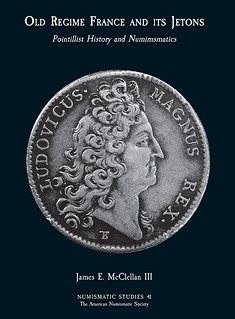 Old Regime France and its Jetons
Old Regime France and its Jetons
Pointillist History and Numismatics
(Numismatic Studies 41)
by James E. McClellan III
List price: $100 plus shipping & handling
Member price: $70 plus shipping & handling
ISSN 0517-404X
ISBN 978-0-89722-362-1
Hardcover, xiii + 268 text pages, b/w figs.
Non-monetary tokens known as jetons originated as counters used on medieval counting tables. In certain parts of France, the Low Countries, and German lands, they continued as such into the nineteenth century. The historical and numismatic interest in jetons stems more from what else they became, particularly though the end of the eighteenth century under the Bourbon monarchs, as perks of office for office holders in the burgeoning nation state of France, New Year's Day presents exchanged among certain segments of society, and lagniappe handed out for attendance at meetings in town halls, regional estates, and learned societies.
Jetons figured in the rites and rituals of the guilds and faculties; they were swag for general meetings of the clergy, and they served as calling cards for noble families. Decoding hidden messages became a parlor game for cognoscenti, and as "petit monuments" some jetons are miniature works of high art produced by the world's most talented artists/engravers at the world's preeminent mint. In this book jetons serve as microdots in a pointillist, longue durée account that paints a grand portrait of early modern and Old Regime France leading up to the French Revolution.
ABOUT THE AUTHOR
James E. McClellan III is professor emeritus of the history of science at Stevens Institute of Technology. He has published widely on eighteenth-century French science, scientific institutions,
scientific publications, and science and colonial expansion. Decades ago, from his work on French academies, Jim learned of jetons de présence—little silver tokens handed out for attendance at
academy meetings—and he began collecting jetons. Along the way he encountered an unexpected divide separating communities of historians and numismatists specializing in early modern and Old Regime
France, and he decided to investigate. He came to see that through the lens of these tiny, almost trivial artifacts from the past, a vast panorama opens up on the whole of society and culture of
France through to the French Revolution. This book is the result of that inquiry, proving once again just how contingent the course of historical research actually is.
Order this title from our distributor, Casemate Academic/Oxbow Books. ANS Members, use your discount code at checkout. Forgot the code? Email Emma Pratte, or call 212.571.4470 x117.
For more information, or to order, see:
Old Regime France and its Jetons (http://numismatics.org/store/ns41/)
NEW BOOK: MEDALLIC HISTORY OF SLAVERY
Ben Weiss has written a well-researched 265-page book on the medallic history of slavery, and published it free online. Thank you! Here's his description of the work, which took many years to complete. -Editor
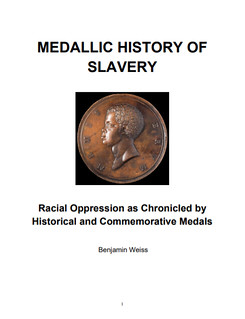 In remembrance of the four hundredth anniversary of the first enslaved Africans brought to the shores of America and to add to our recognition of African American History Month, I offer
your readers, free of charge, a book I just finished writing. It is titled, MEDALLIC HISTORY OF SLAVERY: Racial Oppression as Chronicled by Historical and Commemorative Medals.
In remembrance of the four hundredth anniversary of the first enslaved Africans brought to the shores of America and to add to our recognition of African American History Month, I offer
your readers, free of charge, a book I just finished writing. It is titled, MEDALLIC HISTORY OF SLAVERY: Racial Oppression as Chronicled by Historical and Commemorative Medals.
A brief summary of this work follows:
"The institution of slavery is "no doubt the greatest of all evils that afflict humanity". Alexander von Humboldt (German geographer, naturalist and explorer) 1800."
 During the sixteenth to nineteenth centuries, millions of black men, women and children were captured in their ancestral homelands, often deep in the interior of sub-Saharan Africa,
forcibly marched to West-African coastal embarkation points, chained inside the hold of a cargo ship, transported thousands of miles away to a foreign land where they did not even know the language,
and then, frequently separated from their families, were sold like cattle and kept enslaved for the remainder of their lives. What follows is a brief account of this period, using historical and
commemorative medals to illustrate this sordid epoch.
During the sixteenth to nineteenth centuries, millions of black men, women and children were captured in their ancestral homelands, often deep in the interior of sub-Saharan Africa,
forcibly marched to West-African coastal embarkation points, chained inside the hold of a cargo ship, transported thousands of miles away to a foreign land where they did not even know the language,
and then, frequently separated from their families, were sold like cattle and kept enslaved for the remainder of their lives. What follows is a brief account of this period, using historical and
commemorative medals to illustrate this sordid epoch.
We will follow the slave trade from its origins in Africa to the plantations of the Americas. We explore the early efforts to abolish the trade of enslaved peoples in England and investigate the causes and subsequent consequences of their emancipation in the United States. These latter sections include chapters on the Enslaved People's Attempts to Escape Bondage and touch upon the causes of the American Civil War as they relate to the issue of slavery, the Reconstruction Era, and the Twentieth Century Advances in the Civil Rights of African Americans, again using commemorative medals to serve as primary sources and contemporary media to document these events.
During our journey we will consider a few of those individuals who have made a significant impact on the liberation of enslaved and racially oppressed people. We will touch upon not only those whose names roll off our tongues — like William Wilberforce, John Brown, Frederick Douglass, Martin Luther King, and Abraham Lincoln — but also some of those ordinary people whose lives have made an extraordinary impact in moving our society forward towards justice — such as William Knibb, Robert Smalls, Sojourner Truth, and Rosa Parks — again using commemorative medals to chronicle their historic contributions toward racial justice.


I have included (below) a link to the entire book (consisting of 265 pages and 186 figures) which readers may download free of charge.
To read the complete article, see:
http://www.historicalartmedals.com/MEDALLIC%20HISTORY%20OF%20SLAVERY.pdf

BANKNOTE BOOK MPC CHAPTER PUBLISHED
Owen Linzmayer publishes The Banknote Book, a useful, constantly updated electronic reference. On February 28, 2020 he announced via email the availability of the chapter on United States Military Payment Certificates (MPCs). It's available for $9.99. -Editor
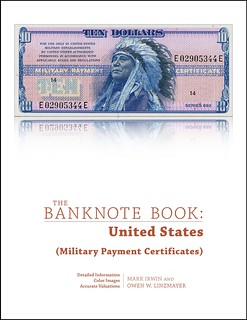 Prolific contributor Mark Irwin has done it again with this week's publication of the United States chapter covering Military Payment Certificates.
Prolific contributor Mark Irwin has done it again with this week's publication of the United States chapter covering Military Payment Certificates.
United States (North America)
This 32-page catalog covers Military Payment Certificates issued by the United States from 1946 to 1970. Published 27.02.2020.
For more information on The Banknote Book, see:
http://www.banknotenews.com/banknote_book/banknote_book.php
AINA OFFERS DIGITAL AND PRINTED SHEKEL MAGAZINES
Mel Wacks of the American Israel Numismatic Association submitted this information about the organizations latest journal issues, along with a special offer for E-Sylum readers. Thank you! -Editor
Plus Bonus Woman Suffrage Challenge Coin
For 2020, the award-winning Shekel Magazine, "The Quarterly Journal of Israel and Jewish History and Numismatics," published by the American Israel Numismatic Association, will be available in digital as well as printed format. There are three membership options: "Bronze" members will receive the digital Shekels plus a Woman Suffrage 1 ½" Challenge Coin for just $18; "Silver" members will receive printed Shekels for $25; and "Gold" members will receive digital and printed Shekels plus the Woman Suffrage Challenge Coin. Mention that you read about this offer in The E-Sylum and as a bonus you will receive three past annual AINA membership medals. To join AINA, call 818-225-1348 or send check to AINA, PO Box 20255, Fountain Hills, AZ 85269.
The first 2020 issue of The Shekel includes articles on medals commemorating the Church Of The Nativity in Bethlehem, violinist Henryk Wieniawski, Jewish American women, the Six-Day War, and the Anwar Sadat Congressional Gold Medal; Palestine Mandate banknotes reproduced in silver; two articles about ancient Judaean Shekels; and a fascinating story about the coins issued by a Sephardic merchant of Barbados. The second issue will feature a comprehensive article about the 30 Pieces of Silver, by Haim Gitler, Curator of Numismatics at the Israel Museum.
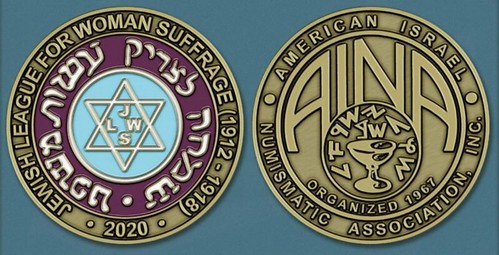
A photograph of the Woman Suffrage Challenge Coin is above. The design is copied from the logo of the only Jewish women's organization in the world devoted exclusively to obtaining the right to vote for women – the Jewish League for Woman Suffrage – operating in England a century ago.
For more information on the American Israel Numismatic Association, see:
http://www.theshekel.org/

VIDEO: U.S. MINT DIRECTOR EVA ADAMS
The latest addition to the Newman Numismatic Portal is an interview with U.S. Mint Director Eva Adams. Project Coordinator Len Augsburger provided the following report. -Editor
Eva Adams (1908-1991) Video on Newman Portal
 The David Lisot Video Library on Newman Portal, numbering about 2,000 videos, is a resource that will be mined for a long time. In 1988 Ed Rochette interviewed former U.S. Mint Director Eva
Adams, who served from 1961 to 1969, and this video has recently been added to NNP. Adams speaks on a number of topics, including the Mint's relationship with coin collectors and concerns related to
public acceptance of coinage changes.
The David Lisot Video Library on Newman Portal, numbering about 2,000 videos, is a resource that will be mined for a long time. In 1988 Ed Rochette interviewed former U.S. Mint Director Eva
Adams, who served from 1961 to 1969, and this video has recently been added to NNP. Adams speaks on a number of topics, including the Mint's relationship with coin collectors and concerns related to
public acceptance of coinage changes.
Adams covers the introduction of the Kennedy half dollar as well as the 1960s coin shortages and subsequent introduction of clad coinage. The former Mint Director opposed legislation that would have removed presidents from U.S. coins and replaced them with figures emblematic of Liberty. Adams concludes with a few remarks on the construction of the (fourth) Mint in Philadelphia, which opened in 1969 during the final year of her administration.
Image: U.S. Mint Director Eva Adams, speaking in 1988.
Link to Eva Adams video on Newman Portal:
https://nnp.wustl.edu/library/book/578942
VIDEO: "FOXY" STEINBERG INTERVIEW
E-Sylum supporter Bob Steinberg submitted these notes on another Lisot video recently uploaded to the Newman Numismatic Portal. Thanks. -Editor
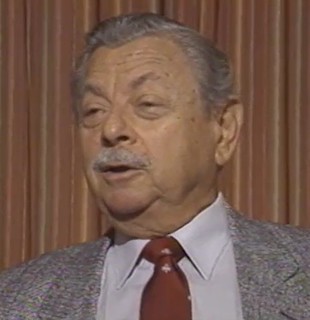 Next month is the 25th anniversary of the passing of my dad--William Fox "Foxy" Steinberg. I thought this might be a good time to look back at this interview done by David Lisot
for the PNG project in 1988--hard to believe that was 32 years ago!
Next month is the 25th anniversary of the passing of my dad--William Fox "Foxy" Steinberg. I thought this might be a good time to look back at this interview done by David Lisot
for the PNG project in 1988--hard to believe that was 32 years ago!
For those of you old enough to remember "Foxy" this short video interview should bring a smile to your face---for those of you who didn't know him (or weren't born yet!) Check it out to get a sense of his personality--as he was an "original character" of our industry in every sense of the word!
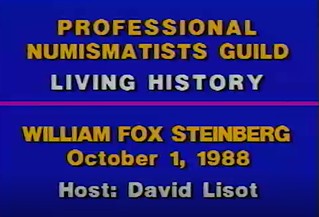 This interview with my late father was done by David Lisot as part of a Professional Numismatists Guild project to interview old time members before they passed away and get them on
videotape! This was back in 1988 (Foxy would have been 75 at the time of the interview) Check it out as I think you might find it interesting--he passed away in 1995--he was one of the founders of
Florida United Numismatists (FUN) and one of the early members of PNG and the the International Association of Professional Numismatists (IAPN).
This interview with my late father was done by David Lisot as part of a Professional Numismatists Guild project to interview old time members before they passed away and get them on
videotape! This was back in 1988 (Foxy would have been 75 at the time of the interview) Check it out as I think you might find it interesting--he passed away in 1995--he was one of the founders of
Florida United Numismatists (FUN) and one of the early members of PNG and the the International Association of Professional Numismatists (IAPN).
To watch the complete video, see:
PNG Living History: Wm. Fox Steinberg, 10/1/88 (https://nnp.wustl.edu/library/book/578940)

AMERICAN INSTITUTE OF PROFESSIONAL NUMISMATISTS
Last week we discussed a sheet illustrating "How Coins Are Made" and a booklet by Walter Breen called The Minting Process from the American Institute of Professional Numismatists. I reached out to Ron Gillio, who was listed as the publisher. -Editor
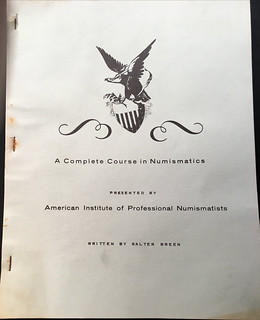
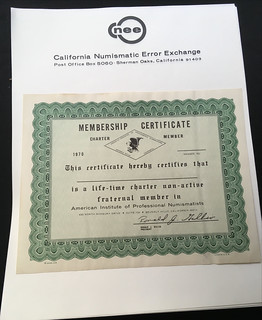
I actually started the AIPN in 1968. The first booklet written by Walter Breen in 1968 (photo attached) was a complete course in numismatics with a test in the back that I sold for $10 at the time. When the person completed the course, they received a membership certificate (photo enclosed.) In 1970 we presented the course ‘The Minting Process' – the one you mention in your article. I was in my early 20s and one of the items in which I dealt heavily was error coins. I thought it would be interesting for people to read about numismatics, take tests, and learn how coins were minted and how errors could occur.
At that time I lived in Sherman Oaks, over the hill from Beverly Hills, and had a company called California Numismatic Error Exchange that focused on selling error coins. Customers that bought the courses also received a copy of my price list on error coins. As I continued doing business into the 1970s, I offered other material related to minting. One item in particular was ‘defaced 1968-S coin dies' that I purchased from Gary Young and Wayne Pratali, who were located in the bay area in those days. I offered the dies through the AIPN, in Beverly Hills at that time, and the dies sold quite well.
Going forward to current times: at the Long Beach Show last week I had a conversation with Fred Weinberg about the dies. He asked me if there were any 1968 dies that were not defaced and I told him that all were defaced and I did not recall any that were not. He went on to tell me that he bought a 1968 nickel die that was not defaced, and the details were completely visible, from a dealer who acquired it from one of my customers who bought it in the 1970s. I explained to Fred that I had thousands of dies back then and was selling so many that I could not look at them all.
Business eventually slowed down and the AIPN has not been active since about 1980.
Thank you! Submissions like this are my favorite part of The E-Sylum. When a question comes up, who better to answer than someone with direct knowledge who was there at the time? -Editor
To read the complete article, see:
WAYNE'S NUMISMATIC DIARY: FEBRUARY 23, 2020 : Mints and Minting (https://www.coinbooks.org/v23/esylum_v23n08a24.html)

NOTES FROM E-SYLUM READERS: MARCH 1, 2020
Correction Corrected
John Isles of Hanover, Michigan writes:
"Princess Anne is most certainly Queen Elizabeth's daughter. Mike may be thinking of Princess Margaret, who was Elizabeth's sister.
I expect a thousand other readers will be telling you this! Thanks for all the good work and best wishes"
Martin Purdy of New Zealand writes:
"The original was correct. Princess Anne is the Queen's daughter (born 1950), the younger sister of Prince Charles. Your correspondent Mr King may have been thinking of the Queen's sister Princess Margaret in error. The medal was thus from just the one person, who happened to be both the reigning Queen and Anne's mother, as originally stated."
Mike King writes:
"My apologies, but I was mistaken about Princess Anne. She was the daughter of the current queen."
Thanks also to Barbara Bailey, Jim Duncan of New Zealand, Philip De Jersey, Scott Miller, and Christof Zellweger of Switzerland.
My apologies for the confusion. This was one of the last items I had time to add to the last issue. I sent a copy to Mike but didn't see his correction until after the issue had gone out Sunday night. We removed the incorrect note from the ANA Edition and our archive.
Remember, The E-Sylum is a discussion forum and articles are not generally researched or fact-checked once received from a submitter. Our readers are the best numismatic fact-checkers in the world - thanks! -Editor
Ancient Gems and Their Connection to Coins

Emma Pratte of the American Numismatic Society notes that the March 11, 2020 lecture by Pawel Golyzniak titled Ancient Gems and Their Connection to Coins: An Introduction will begin at 5:30pm EST. See the earlier article (linked below) for more information. -Editor
To read the earlier E-Sylum article, see:
ANCIENT GEMS AND THEIR CONNECTION TO COINS (https://www.coinbooks.org/v23/esylum_v23n08a21.html)
More on Overstruck Russian Coppers
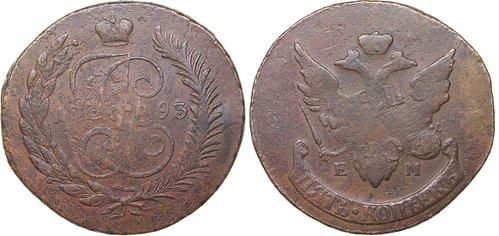
Regarding Steve Bishops's overstruck Russian piece, Ken Spindler of San Diego writes:
"That is one of my favorite historic Russian coins. What that coin is, is a coin that was re-struck twice. It started out life as a 5 kopecks, and was re-struck as a "cipher" 10 kopecks dated 1796, in a surreptitious government plan to double some of the government's money. The cipher was a very large cursive Cyrillic E, abbreviation for Ekaterina, for Tsarina Catherine (the Great). The government saved up about 500,000 5-kopeck coins and started to re-coin them as 10-kopeck coins with the new cipher design, striking them with great force to try to spread them out (expanding their diameters; also, thinning them) so they would look like they contained enough metal to be accepted at face value. They were also going to acquire new edges, to further fool the public. The secret work was started at multiple mints. I think the scam was the idea of Catherine's finance minister.
"Anyway, Catherine died in 1796, and her son, Tsar Paul I (who disagreed with everything she did) immediately cancelled the project. All of the newly-re-struck 10-kopeck coins were re-struck as 5-kopeck coins again using old dies, so the government could spend them. Surviving original 1796 cipher 10 kopecks are extremely rare. I think I have 4 of these re-struck coins, and am always on the lookout for a bolder cipher. One of mine has a very bold 1796 date. The cipher is usually pretty faint on these if still visible at all. Part of the central horizontal denomination legend still showing from the 10-kopecks undercoin is usually the giveaway, but a circled ball in a field will do the trick, and is exciting to find. (OK, I'm weird.)
"The coin in the photo shows part of the horizontal denomination legend from the 10-kopeck die (inverted and at a slight angle) just below the bottoms of the eagle's necks. There were other denomination-increasing Russian copper recoinages during the 18th century, too. On those, sometimes you can see traces of both of the undercoins; the original denomination coin, the temporarily-increased denomination strike, and the final re-strike of the original denomination using old dies over that, haphazardly rotated from the original strike."
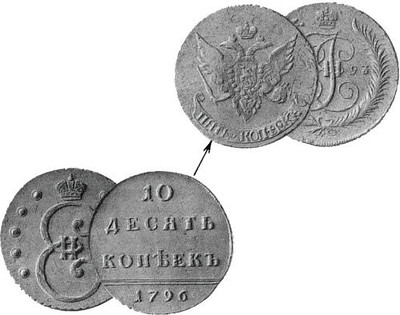
Steve Bishop adds:
"In fact, it is theoretically possible that such a coin may have been struck a total of five times! Here is the possible sequence: a 5 Kopeck piece of Elizabeth, restruck as a 10 Kopeck piece in 1762 by Peter III, restruck again as a 5 Kopeck piece by Catherine II ca. 1763-89, restruck a third time as a 10 Kopeck piece of the Cipher design in 1796, and restruck a fourth time as a 5 Kopeck piece of the usual Catherine II design in 1797 by Paul I. (Can you imagine how one of these coins would feel? "Oh, come on! Make up your mind, already!").
"Obviously, this would be difficult to confirm, as traces of earlier overstriking would have been obliterated by later ones, and thus the third way of discerning coins from the 1797 recoining program is by identifying traces of the 1796 Cipher design under the Catherine II 5 Kopeck design. The most telling clue is remnants of the distinctive dots of the Cipher design. Other prominent traces also found are remains of the large script "E", the 1796 date, and the denomination inscription."
Thanks! Great story, neat coins. -Editor
To read the earlier E-Sylum article, see:
WAYNE'S NUMISMATIC DIARY: FEBRUARY 23, 2020 : Bishop's Beauties (https://www.coinbooks.org/v23/esylum_v23n08a24.html)
Books on Railroad Medals
Last month Sandy Pearl emailed me to ask about books on railroad medals. George Cuhaj and Harry Waterson suggested these. Thanks! Any other suggestions? -Editor
Bennick, David, Compiler – A Compendium of United States and Canadian Railroad and Railroad-Related Medals and Tokens; Self-published in loose-leaf binder, Woodbury, CT 1991 [TAMS seems to list 3 editions of Bennick's thru 1994]
Moyaux, Auguste. LES CHEMINS DE FER AUTREFOIS ET AUJOURD'HUI, ET LEURS MÉDAILLES COMMÉMORATIVES. NOTICE HISTORIQUE SUIVIE D'UN CATALOGUE DESCRIPTIF DES MÉDAILLES DE TOUS LES PAYS. Bruxelles: Charles Dupriez, Éditeur, 1905. Folio [32 by 26 cm], later brown cloth and marbled boards; printed spine label. (4), (ix)-xii, (2), 262, (2) pages; title printed in red and black; decorative initials; numerous text illustrations, some full-page; table; 11 very fine phototypie plates of medals. Some repairs to the opening leaves, a few of which are a bit ragged at margins; blank corners cropped from two page margins, apparently to remove written notes. Very good. An exceptional work on railroad medals. One of 400 examples issued on papier vélin of an entire edition of 425 copies. Clain-Stefanelli 14223. [From a Fanning sale]
One Million Pound Notes at the Bank of England
Kavan Ratnatunga passed along this link to a video about the One Million Pound Notes at the Bank of England. Thanks.
https://www.facebook.com/bbciplayer/videos/one-million-pound-notes-inside-the-bank-of-england/476679362877054/
-Editor

MORE ON SOUTH WEST AFRICA CHITS
Pablo Hoffman of New York City writes:
"Eric Schena's comments in the last E-Sylum led me to offer this short article on a rare and little-known South African series."
Thanks! I enjoyed Pablo's email subject line, which won't fit in our headline format: "Swakopmunder Buchhandlung and Südwestafrikanische Bodenkredit-Gesellschaft." -Editor

Südwestafrikanische Bodenkredit-Gesellschaft 1 Mark
The Swakopmunder Buchhandlung chits, or gutschein, comprise an intricate series of German Southwest Africa, and a prohibitively difficult challenge for completists. There are types, varieties of types, and varieties of varieties. I'll guess that no one individual has seen them all, much less collected them all.
But there's a little-known sequel to these issues that created an intriguing South African series of extreme rarities.
It's probable that one reason the Swakopmunder Buchhandlung gutschein are available to collectors today is because they were fiat currency, i.e., unbacked by hard reserves or deposits, and therefore inconvertible. For that reason the issuer was forced to abruptly halt their production and distribution, as such emissions became banned under orders from the British-backed South African Government's military occupation of German Southwest Africa. South African forces, led by Jan Smuts, victorious in a series of military actions against German and local troops, had taken command of the region. The ban on fiat notes took effect on January 28, 1918, leaving unredeemable Swakopmunder Buchhandlung gutschein, in a multiplicity of denominations and style varieties, scattered throughout the colony.
But despite the prohibition against unbacked notes, Swakopmunder Buchhandlung did not end the emission of gutschein. In 1918 they produced a new series, titled with a new issuing authority, Südwestafrikanische Bodenkredit-Gesellschaft (South West African Land Credit Association,) and backed by reserve asset deposits, thereby sidestepping the ban. These appeared only in denominations of 50 pfennig and one mark, and were designated negotiable at the filiale (branch office} in Lüderitzbucht, a distant baytown in the IIKaras Region on the southwestern coast, some 1200 km. south of Swakopmund, on mostly rough roads.
The life of the Südwestafrikanische Bodenkredit-Gesellschaft notes was brief. As of January 1, 1919, they were quickly redeemed and replaced by notes of the South African Union. Their redemption would have been virtually complete. Unlike the Swakopmunder Buchhandlung notes, they had the guarantee of hard assets behind them. Their thorough convertibility to the successor South African notes would have left a minuscule few for future discoveries.
History was on the march; the fate of the remote and marginally significant colony of German Southwest Africa had been inexorably sealed by the defeat of the German homeland in the macro-event of the first World War. The formal amputation of its colonies was effected by the signing on June 28, 1919, of The Treaty of Versailles. Its Articles 22 and 119 through 127 established South West Africa as a mandate territory under the League of Nations, to be administered by the Union of South Africa. Its inevitable course was thereby set, to be embedded into South Africa and the British Empire.
To read the earlier E-Sylum article, see:
WAYNE'S NUMISMATIC DIARY: FEBRUARY 23, 2020 : South West Africa Chits (https://www.coinbooks.org/v23/esylum_v23n08a24.html)
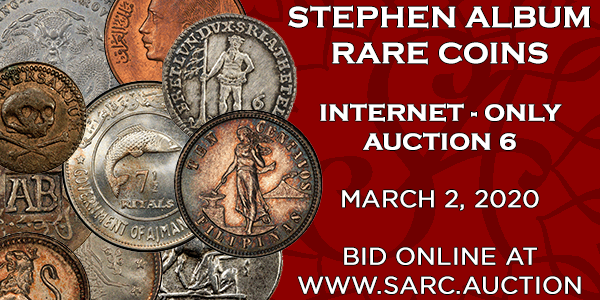
THE NUMISMATIC MARKET AND THE STOCK MARKET
Given this week's big drop in the stock market, Martin Kaplan asked,"How do rare coin and banknote values hold up in times of turmoil on Wall Street?
"When Wall Street is in turmoil, bear market, does this attract money to the rare coin and banknote market?
"Obviously gold and silver bullion attract interest, but numismatic items?"
I passed the questions along to Q. David Bowers, who was written a lot about markets and investing over the years. He referred us to the following passage in his 2005 book, The Expert's Guide to Collecting and Investing in Rare Coins. -Editor
Watching Stock Market Bears
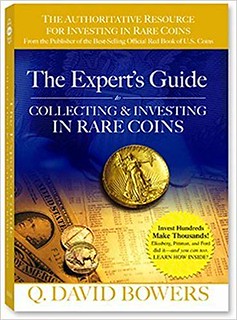 Relating selected bear or down-markets for stocks to the situations at the time with the rare coin market shows this:
Relating selected bear or down-markets for stocks to the situations at the time with the rare coin market shows this:
1930s • Bear stock market of the 1930s Depression: Time of great growth in the rare coin market.
1946-1947 • Bear stock market of May 1946 to May 1947: Boom time for the coin market.
1961-1962 • Bear stock market of December 1961 to June 1962: Boom time for the coin market, when all of those 1950-D nickels were rising in price.
1966 • Bear stock market of February to October 1966: Bear time in the coin market as well as the stock market; gloom prevailed.
1973-1974 • Bear stock market of January 1973 to December 1974: Boom time for the coin market.
1976-1978 • Bear stock market of September 1976 to September 1978: Boom time for the coin market.
1981-1982 • Bear stock market of April 1981 to August 1982: Bears everywhere, in coins and in stocks.
1987 • Bear stock market of August to October 1987: Boom time for the coin market.
1990 • Bear stock market of July to October 1990: So many bears were prowling around the coin market that only Bayer aspirin could solve the headaches!
2000-2003 • Bear stock market of March 2000 for the next several years. NASDAQ peaked at 5048.62 on March 10, 2000, and fell to a bear-market low of 1114.11 on October 9, 2002. The Dow-Jones Industrial Average fell, but not nearly as much, as it was/is composed of more seasoned stocks. The coin market is afire with interest in ultra-high grade certified modern coins.
I discuss separate movements of the rare coin market later in this book. The coin market has had its share of knocks, such as 1947-1950, when stocks were doing very well, but buyers for coins, even rarities, were scarcely seen. A fair summary is to say that while both the coin and stock markets have their own cycles, hardly ever do the twain meet.
It is also probably fair to say that choice rare coins have been a great passive investment, when bought carefully and held. In contrast, successful investing in stocks would seem to require constant management. The darlings of a generation ago can be dead today.
Martin adds:
"The real story of how alternative assets, numismatics, fare in times of turbulence will be revealed in the Stack's auctions in Baltimore."
1) might the sale be cancelled?
2) might there be added interest in alternative assets and records broken as predicted?
"Stay tuned!"
Thanks. Great questions and discussion.
A new virus and potential global pandemic are certainly enough to cause major public events to be cancelled, such as the postponed Hong Kong show. But so much bidding takes place online these days I think the worst outcome for auctions in areas far from the outbreak would be to cancel in-person bidding and carry on online. Financial gyrations could indeed affect the level of bidding, but as Dave's notes indicate, there's no apparent correlation; the coin market could be up, down or just sideways. Like Martin says, we'll see. -Editor
To read the earlier E-Sylum article, see:
2020 HONG KONG SHOW AND SALE POSTPONED (https://www.coinbooks.org/v23/esylum_v23n08a20.html)
THE BOOK BAZARRE
VOCABULARY TERM: IMPRESSED ERROR
Dick Johnson submitted this entry from his Encyclopedia of Coin and Medal Terminology. Thanks.
Last week's entry was on Impressed Designs, where a piece of metal or other hard object is deliberately placed onto the surface of a planchet before striking, typically to produce a "relic" medal. But when the same thing happens by mistake, it's another animal. -Editor
Impressed Error. A striking error in which foreign matter is lodged on and impressed into the surface of a struck piece. The foreign matter comes between the die and the blank before striking; and after striking it is retained below the surface but later may or may not flake off or dislodge. Thus an unusual shaped depression on a struck surface may be evidence that some object had indeed lodged there during striking. As a collector's item it is far more interesting if the impressed object is still intact.
A wide variety of foreign objects have been found impressed on coins and medals including metal scrap of all kinds, wire, staples, diechips, bits and pieces of planchets, other struck pieces, small parts of tooling, and even blanks and struck pieces of smaller diameter. An area containing a letter or detail flaking off one piece (mostly because of a lamination error) falling on a blank and impressed into a second struck piece is called a dropped letter.
Metal shards from any source landing on a blank can be impressed into a coin; more often than not these tiny shards are not retained but fly off. This condition was once called lint marks but this term is a misnomer. A more accurate term for this anomaly is impressed shard mark. Cloth and other nonmetallic items have also been impressed as well as grease which forms wavy areas (rippled surface).
In presswork, impressed errors are eliminated for the most part by blowing compressed air over both dies and blank prior to striking. Collectors' terms for this anomaly is struck-thru and indents, the latter for a blank or struck piece impressed on a piece of larger size. When an object is purposely placed on the surface of the planchet and struck this is called impressed design (see previous entry).
References:
NM19 {1991} Margolis (indents) p 265-270.
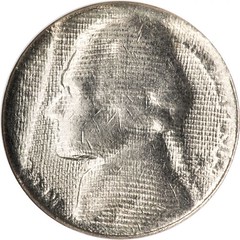
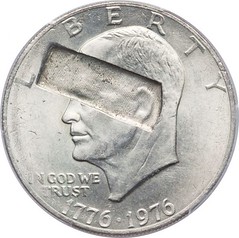
https://coinauctionshelp.com/struck-through-mint-error/
Looking for the meaning of a numismatic word, or the description of a term? Try the Newman Numismatic Portal's Numismatic Dictionary at: https://nnp.wustl.edu/library/dictionary
Or if you would like a printed copy of the complete Encyclopedia, it is available. There are 1,854 terms, on 678 pages, in The Encyclopedia of Coin and Medal Technology. Even running two a week would require more than 19 years to publish them all. If you would like an advance draft of this vital reference work it may be obtained from the author for your check of $50 sent postpaid. Dick Johnson, 139 Thompson Drive, Torrington, CT 06790.
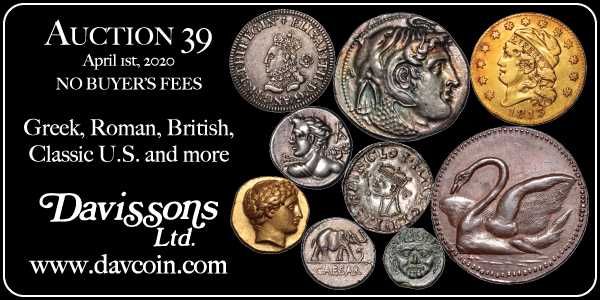
HENRY CLAY MILLER (1844-1920)
He was born in Philadelphia, Pennsylvania, on May 19, 1844, the son of George H. Miller (1818-1888) and Emma M. Stellwagon Miller (-1855). He was a student of Samuel M. Cleveland studying with him as a college prep student. In 1864, he entered Williams College, Williamstown, Massachusetts (founded 1793) and was a graduate in 1867. His graduation speech was on aesthetics, "The Perception of Beauty".
He taught at the Lake Forest Academy, Illinois from 1867-1868, under principal L. M. Johnson. He left the Academy and became a chemist at Philadelphia from 1868-1871 beginning in the lab of Dr. Bruckner. But, for the next three years he was the principal of Miller & Cummings and worked with his old school chum Jones in the business of importing drugs and sundries. Due to poor health he retired for eighteen months (1871-1873) in the Rocky Mountains engaging in mining.
He returned to the Lake Forest Academy, Illinois for one year term (1873-1874). From 1874-1875, he taught at the Trenton Normal School, Trenton, New Jersey, teaching Latin and German. From 1876-1886, he was one of the three directing principals of the Hasbrouck Institute, 109 Grand Street, Jersey City, New Jersey, founded in 1856. Although he continued in the Hasbrouck School from 1881-1886 he sold off his interest in the School in 1881.
On December 24, 1878 he married Effie Wilkes. She died on November 1880.
From 1881-1887, he was one of three directors of the New-York School of Languages, 1479-1485 Broadway, near 43rd Street, New York. From 1889, he was a principal with Arthur Williams of the Dwight School, New York, 1481 Broadway, corner of 43rd Street, where he was one of the founders in 1880. The school is a college preparatory school with graduates at Yale, Harvard, Columbia and Williams Colleges for science or business. Miller retired from teaching and school administration in 1895. From 1895 on he became an investment financier and stockbroker in New York with Goodbody & Co., and amassed a fortune.
He was a member of the British Numismatic Society in 1903. He was a member of the American Numismatic Society, and the New York Numismatic Club. He applied for membership to the ANA in October 1902.
He was a numismatist famous for his attribution guide of Colonial Connecticut coppers, 1785-1788. He collected ancient Roman, Anglo-Saxon as well as American and the other American colonial coin series. He discovered and bought for less than $50 a pair of proof 1796 US Half Cents in London.
Sometime between 1900 and 1910 he moved from New York to Ridgewood, New Jersey. He was 5'-10" with hazel eyes and since about 1910 he was partially bald with gray hair.
Thomas Elder describes his physical appearance as fat and rotund figure and implied that was the result of his voracious appetite for candy. He used to give Lyman H. Low small consignments to sell, and later on transferred his sale trade to Thomas Elder. His collection was sold by Lyman H. Low on June 15, 1897.
He traveled to Egypt returning in March 1907.
Another sale by Thomas Elder on April 13-14, 1917 had 54 varieties of 1794, five of which, had been plated in Gilbert-Elder.
He died in a Hospital from a heart attack on February 5, 1920, after five days of intensive care. He is buried in Laurel Hill Cemetery in Philadelphia.
His sister Miss Emma Miller was instructed by him to give Thomas Elder his remaining collection to sell.
To read the complete article, see:
MILLER, HENRY CLAY
(https://sites.google.com/site/numismaticmallcom/encyclopedic-dictionary-of-numismatic-biographies/miller-henry-clay)

HARVEY STACK'S NUMISMATIC FAMILY, PART 64
The latest article in Harvey Stack's blog series is about the Philadelphia Mint's Bicentennial exhibit of the Eliasberg collection. Thanks, Harvey! -Editor
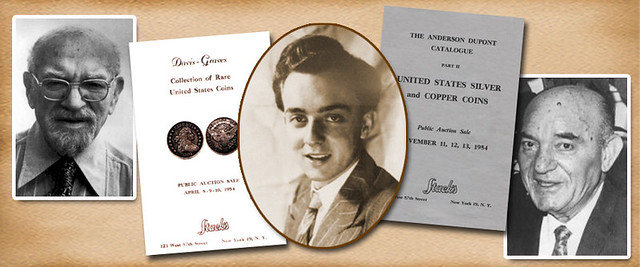
1974 brought a great numismatic challenge that helped to distract me from the sadness of my uncle's passing. Early in January we received an urgent phone call from Dr. Vladimir Stefanelli, curator of the National Coin Collection at the Smithsonian Institution and he sounded troubled. The conversation started with a plea: "Can you help me out. I have a very serious problem and hope you can think of an answer."
I quickly asked if he and his wife were alright and he answered that they were fine. I then inquired as to whether the coins at the collection were safe, not stolen. To this he answered: "No not stolen, worse!" I immediately thought that there might have been a fire or that the building had fallen down, but he assured me that was not the problem. However, he was adamant that the Smithsonian might lose a major part of the collection if we could not come up with a resolution to the problem.
To my incredulous questions, the good doctor, took a breath and related what happened:
He told of how they had been planning a great exhibit to tell the monetary history of our Republic as part of the nation's Bicentennial celebration in 1976. They had been working on the exhibit since the previous year, as I well knew as I had been helping to acquire some pieces on loan from private collections to enhance the display. He and his wife had spent endless hours on the exhibit. Their plans included showing how coins were made and used from colonial times to the present, exhibiting all the denominations and designs, as well as patterns that were considered and drawings that precluded the final designs. It was to be a very comprehensive display that comprised much of the collection, as well as pieces from outside sources.
However, he told me, the United States Mint in Philadelphia also wanted to stage a grand display for the Bicentennial, and to that end, they had requested that the coins that had been sent from the Mint to the Smithsonian for the National Numismatic Collection be returned. The Mint wanted the coin collection to be in that facility for their Bicentennial celebration. To the Stefanellis and their planned display for the Smithsonian this would be a powerful blow.
At that moment I did not have an answer for them. "Let me give this some thought, and I will talk with Norman in the office," I said. "Maybe we can think of a way to keep the coins at the Smithsonian."
When I arrived at the office the next morning, I sat down with Norman at the "partners' desk" that my father and uncle used to use. Now Norman and I shared that office with the seats set up to face each other. I presented the problem that Val (Dr. Stefanelli) had told me about and asked Norman what ideas he might have. As we discussed this back and forth, an idea came to my mind.
I remembered that when Norman and I went to Baltimore the year before to do some work for Louis E. Eliasberg, he mentioned that he wanted to display and gain some recognition for his complete collection, and then he would consider selling it. The thought came to me: what if Louis Eliasberg was willing to exhibit his collection at the Philadelphia Mint during the Bicentennial. This would offer him the opportunity to gain the national recognition his collection so deserved, as it was the only complete collection ever assembled of United States coins in all metals, gold, silver and copper. Millions would visit the Mint, as Philadelphia was at the epicenter of the Bicentennial celebrations, with many landmarks of our Founding Fathers and the earliest days of our nation's history.
"Wow, what an idea!" Norman exclaimed. He agreed that if we could get Mr. Eliasberg on board and convince those at the Philadelphia Mint that this would be a super, unique display, this would solve the problem for the Smithsonian and create not one, but two fabulous numismatic exhibits for the country's 200th birthday. He suggested I call Mr. Eliasberg and see if he had any interest in the idea.
So, I got my thoughts together and called Lou on the phone. He was out of the office for about an hour, so I left a message with Miss Doris Everding, his personal secretary , who had worked with Eliasberg for over 30 years. I waited for the call, and about an hour later the phone rang and Lou was on the phone.
"How are you, my boy (his customary greeting)? I understand you have something special to talk to me about. So go ahead." I reminded him of our conversation about exhibiting and gaining national attention for his collection. I asked whether he would he consider putting it on display at the Mint in Philadelphia during the Bicentennial celebrations. I suggested it would be a great place for his collection to be seen by millions of people visiting Philadelphia for the occasion. I felt that many more people would see it there than would have on a nationwide train exhibit we had discussed the year before. In addition, there would be no expense for moving the collection or insuring or guarding it.
There was a complete silence on the phone for about a minute, which felt like an hour. Then, I heard Eliasberg's loud and clear voice: "What a super idea. I wish I had thought of it." He continued: "I love the idea. Can you get the Treasury Department and the Mint to agree?"
I responded that I thought I could, but wanted to be sure of his enthusiasm first. I told him that I would first propose it to Dr. Stefanelli and the senior officials at the Smithsonian. Together with them, we could submit the idea to the Treasury and Mint, and convince them that the Eliasberg Collection, already prepared for display, would be a much more effective exhibit than just laying out the coins from the National Coin Collection without the guidance of many numismatists. Mr. Eliasberg agreed that we could move forward with the negotiations.
We started that day. First I called Dr. Stefanelli and told him of our idea. He was very excited about the possibilities of the plan. I then said to him: "Now the ball is in your court! You were approached by the Treasury and Mint to return parts of the National Numismatic Collection. Now you can offer them a better idea."
We discussed the selling points for the Mint:
• It was the only complete collection of United States coins ever assembled.
• It had already been displayed in the 1940s and 1950s in banks in Baltimore and always attracted crowds.
• It was already mounted in huge frames whereby interested viewers could see both sides of the coins.
• The coins were all labeled.
• All that would be required was large flat display tables to stand the racks on. In addition, moving the collection from Baltimore to Philadelphia and providing guard service during the display would be about the only costs for the Mint. Either Mr. Eliasberg (who is not well at the time), or his son Louis, Jr. would pack the collection for shipping, unpack and set it up in the Mint, and then repack it when the display was concluded. All in all, the benefits to the Mint were impressive.
Dr. Stefanelli took the idea to the Chairman of the Museum of American History, where the Numismatic Collection was displayed and stored. He in turn contacted Mint officials who took the idea to the office of the Treasurer. I had to go to Washington to formally explain the idea. I also made a trip to Baltimore with staff to see what was going to be on display and to negotiate some security terms with Mr. Eliasberg. Within two weeks the idea was accepted and the Smithsonian was able to retain the coins it had in Washington and create the Bicentennial exhibit they had planned. For me it was a "once in a lifetime event," and I was pleased with the success of the idea and how well the negotiations had gone, for dealing with government officials was not really my cup of tea!
When I reach the year 1976 in my story, there will be more to tell about what happened later with this deal.
To read the complete article, see:
Harvey Stack Remembers: Growing up in a Numismatic Family, Part 64
(https://www.stacksbowers.com/News/Pages/Blogs.aspx?ArticleID=Harvey-Stack-Remembers-Part-64)
To read the earlier E-Sylum article, see:
HARVEY STACK'S NUMISMATIC FAMILY, PART 63 (https://www.coinbooks.org/v23/esylum_v23n07a20.html)
LONG BEACH ANTI-COUNTERFEITING SEMINAR REPORT
This press release describes the recent Long Beach anti-counterfeiting seminar for law enforcement officials. -Editor
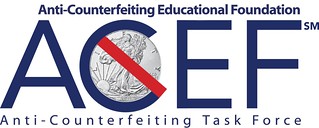 A seminar for law enforcement officials conducted by the Anti-Counterfeiting Educational Foundation (ACEF) during the recent February 2020 Long Beach Coin, Currency, Stamp & Sports
Collectibles Expo already has produced positive results in the fight against fakes in the numismatic marketplace.
A seminar for law enforcement officials conducted by the Anti-Counterfeiting Educational Foundation (ACEF) during the recent February 2020 Long Beach Coin, Currency, Stamp & Sports
Collectibles Expo already has produced positive results in the fight against fakes in the numismatic marketplace.
The seminar's objective was to bring together representatives of federal and local agencies that come into contact with counterfeits or investigate counterfeits, and educate them about the expert resources available from ACEF's Anti-Counterfeiting Task Force to assist during their investigation and prosecution of cases.
"A total of 40 law enforcement officers and agents attended the Counterfeit and Precious Metals Investigation class held on February 20 in Long Beach, California. There were representatives of the Secret Service, Customs and Border Protection, the U.S. Justice Department and Homeland Security as well as the Los Angeles Police and Sheriff's Departments and other Southern California law enforcement agencies and the United States Mint," explained Doug Davis, ACEF Director of Anti-Counterfeiting.

In addition to Davis, expert speakers during the four-hour seminar included former American Numismatic Association President Robert Campbell and former Numismatic Guaranty Corporation authenticator Brian Silliman as well as Chris Hersey of the U.S. Treasury Department's Office of Inspector General and Joe Boche with the Minnesota Fraud Bureau.
"The feedback from attendees was very positive," stated Davis, a former Texas police chief. "The class immediately opened up new lines of communication between ACTF, the Secret Service and Homeland Security. Attendees have already reached out and joined ACTF's online Law Enforcement Portal and I have been asked to speak and teach at different field offices of Customs and Border Protection and Homeland Security Investigations."
As part of ACTF's aggressive approach in attacking the problems of counterfeit coinage, in just the first weeks of the year the organization has assisted Customs and Border Protection on two cases involving the seizure of over 3,000 counterfeit coins and ingots at two different U.S. ports of entry.
The ACEF is a 501(c)(3) corporation and its important anti-counterfeiting work is supported entirely through tax-deductible donations to the organization.
For additional information, contact the Anti-Counterfeiting Educational Foundation by phone at 817-723-7231, by email info@ACEFonline.org or visit the web site at www.ACEFonline.org.
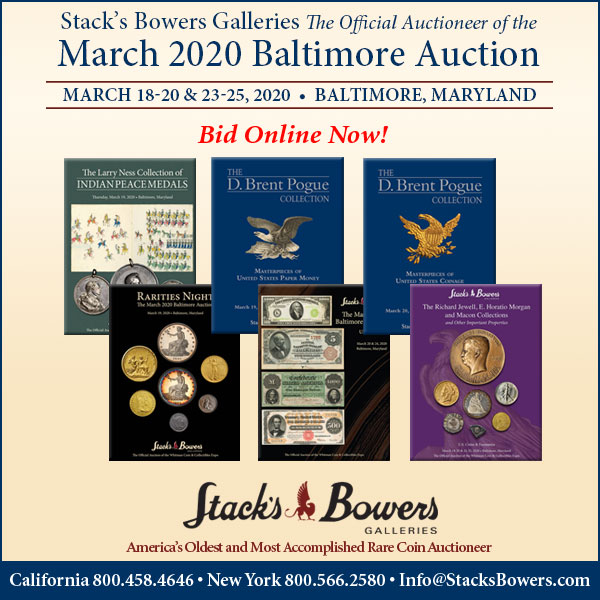
ANS MONEY TALKS: BEFORE THE COINAGE ACT OF 1857
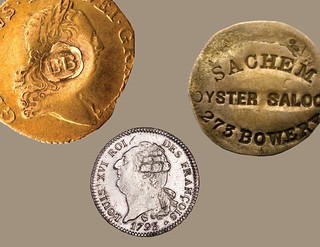 Money Talks:
Money Talks:
Before the Coinage Act of 1857: How Americans Spent Foreign Coinage
With Dr. Jesse Kraft
Saturday, March 14
1:00 pm – 4:00 pm
$30 for ANS members
$50 for non-members
From the earliest days of the British-American colonies, up through the late 1850s, a variety of foreign coinage circulated in the United States. At various times, coins from Spanish-America, Great Britain, France, and Brazil held legal tender status and formed a majority of the hard-money supply in the United States. Most of these coins did not conform to the predominant unit of account (i.e. "dollars" or "pounds") and forced American consumers and merchants to navigate this system through a variety of ingenious, though sometimes confounding methods.
This Money Talks discusses those methods, including the use of abstract mathematical formulas, a variety of exchange charts, the prolonged usage of British monetary terminologies, and ways to evade the heightened threat of counterfeit coins. Despite these hindrances, certain coins could freely circulate largely due to the familiarity that several generations of Americans had with them. It was not until consumers and merchants had to contend with new and different types of foreign coins (ca. 1840s and 1850s) that the system finally came to a halt.
Space is limited. RSVP to Emma Pratte at membership@numismatics.org
Money Talks: Numismatic Conversations is supported by an ANS endowment fund generously given in honor of Mr. Vladimir Clain-Stefanelli and Mrs. Elvira Clain-Stefanelli.
To read the complete article, see:
Money Talks: Before the Coinage Act of 1857: How Americans Spent Foreign Coinage (http://numismatics.org/mar2020-money-talks/)
ROCKWELL LECTURE: WOMEN, POWER, AND MAGIC
John Ferreri submitted this announcement of this year's Rockwell Lecture. Three Boston-area clubs have been sponsoring this special event for over a decade. -Editor
Tuesday April 14, 2020
Sponsored yearly by the Collectors Club of Boston, Boston Numismatic Society, and the Currency Club of New England 7-9PM at New Light Korean Church 730 Main St. (Rt 20) Waltham, Mass. Light refreshments will be served.
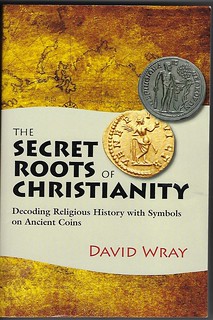 Area numismatists are invited to attend this special lecture given by David Wray on: Women, Power, and Magic in 13 Ancient Artifacts.
Area numismatists are invited to attend this special lecture given by David Wray on: Women, Power, and Magic in 13 Ancient Artifacts.
David is retired from a career as Program Manager in early internet companies. He also is one of the founders of the Writing Program at the Massachusetts Institute of Technology. And, he is a prize winning author and lecturer. He now pursues his interests in numismatics, history and archeology. He is author of: The Secret Roots of Christianity: Decoding Religious History with Symbols on Ancient Coins.
David has chosen to show 13 artifacts from his collection related to women and prepared an entertaining introduction to a serious historical topic. The ages of the artifacts range over 3000 years, from ~1600 B.C. to the 16th century A.D. Only some of the artifacts are coins. Taken all together, the artifacts in this overview suggest that thematic connections between women and magic relate in fascinating ways to gender power in various societies across millennia.
If additional information is needed please contact:
William Harkins williamharkins@comcast.net -or-
John Ferreri johnnybanknote@yahoo.com
John adds:
"Most people out of this area probably won't know David Wray. He is a captivating speaker and has given programs for various numismatic clubs in the New England area for years."
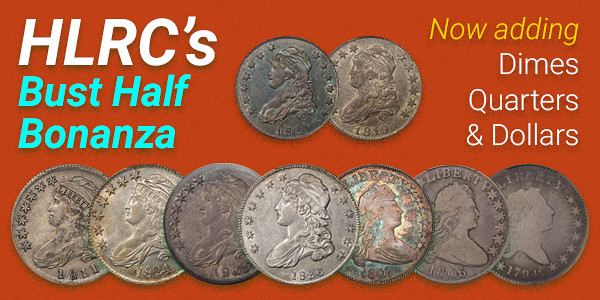
CENTRAL STATES CONVENTION ANNOUNCES PROGRAMS
This press release describes the educational programs, meetings and seminars scheduled for the upcoming Central States Numismatic Convention. -Editor

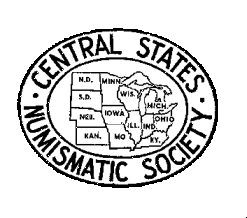 The 313 booth Central States Numismatic Convention, with public bourse hours Wednesday through Saturday, April 22-25, has announced its schedule of educational programs, meetings and
seminars. The convention will be held at the Schaumburg Convention Center and adjoining Renaissance Hotel, ten miles from Chicago's O'Hare Airport adjacent to the westbound I-90 freeway, at 1551
North Thoreau Drive.
The 313 booth Central States Numismatic Convention, with public bourse hours Wednesday through Saturday, April 22-25, has announced its schedule of educational programs, meetings and
seminars. The convention will be held at the Schaumburg Convention Center and adjoining Renaissance Hotel, ten miles from Chicago's O'Hare Airport adjacent to the westbound I-90 freeway, at 1551
North Thoreau Drive.
Mitch Ernst, CSNS president and acting education director, said of the educational lineup, "I really do think our 2020 convention will feature the strongest array of programs, club meetings and seminars we've been privileged to ever present."
Leading off on Monday, April 20 will be a two day seminar by Robert Campbell and Brian Silliman, Counterfeit Coin Detection. Also getting underway on Monday will be a two day presentation
by Glen Jorde and Col. Joseph Boling, Advanced Paper Money Grading. Each of these seminars held prior to the Wednesday opening of the bourse area requires advance registration and a $150
enrollment fee. Those interested in attending either of the two pre-bourse seminars should contact
president@centralstatesnumismaticsociety.org.
On Thursday, April 23, William Anderson will present Civil War Store Cards at 11AM. Also at 11AM, William Bierly will be talking on his acclaimed book In God We Trust: The American Civil War – Money, Banking and Religion. At 1PM that day William Brandimore will share Collecting Colonial Paper Money. Brandimore will be followed at 3PM by Pierre Fricke on The History of Collecting Confederate Currency. Both Brandimore's and Fricke's presentations will be part of a specialized paper money focused Professional Currency Dealers' Association Educational Forum. The CSNS convention will also be incorporating this year the 35 th Annual National Currency Convention, an event that had previously been held by the PCDA on an independent basis. Thursday's programs will conclude at 5PM with an ANA Judges Certification program hosted by CSNS Chief Judge Col. Joe Boling and CSNS Educational Exhibit Chairman Brett Irick.
Highlight of Friday's programs will be the multi-session Heritage Auctions Educational Forum. Leading off at 9AM will be Doug Davis, talking on behalf of the Anti-counterfeiting Educational Foundation on Current Anti-counterfeiting Initiatives and Progress: A Model of Private Sector and Law Enforcement Cooperation. The Heritage Forum will continue at 11AM with Cliff Mishler and David Harper on Remembering Chet Krause: Memories by Two Friends and Colleagues. The final session of the Heritage Forum will convene at 1PM for a panel discussion moderated by Harper, a past editor of Numismatic News. It will feature Mishler, past president of Krause Publications, Corrine Zielke, current publisher of Numismatic News, Rick Amos, president of Amos Media and Gerald Tebben, editor of the CSNS Centinel. Their panel will explore The Numismatic Press: Current Challenges and the Future.
Friday will also see meetings and programs sponsored by the Fellowship of Christian Numismatists, the Liberty Seated Collectors Club, the Early American Coppers Club, the International Organization of Wooden Money Collectors and the National Silver Dollar Roundtable. The NSDR meeting will feature a silver dollar educational program by John Highfill, Brian Cushing and Jeffrey Wuller.
Saturday's programs will start off at 8AM with the CSNS awards ceremony and continue at 9AM with a meeting of Women in Numismatics. The WIN meeting will feature Louise Boling and Kathy Freeland speaking on History and Heroines: 100 Years of American Women's Suffrage. The PCDA Educational Forum will reconvene at 11AM to hear David Gelwicks on National Bank Notes from Michigan's Upper Peninsula. At 1PM American Numismatic Society Executive Director Dr. Gilles Bransbourg will address the Chicago Coin Club on Inflation and Coinage Reform in the 4th Century Roman Empire. At 2:30PM former Michigan State Senator Steven Bieda will present A Tale of Three Coins: From the Perspective of a Designer, Legislator and Judge, as he recounts his experiences as the designer of the reverse of the 1992 Olympic half dollar. Saturday will also include a 1PM meeting of the Illinois Numismatic Association board of governors, as well as an 11AM-4PM series of programs for Young Numismatists hosted by the History in Your Hands Foundation. There will also be a CSNS general membership meeting at 10AM.
Featuring a dedicated specialty section of foreign and ancient specialists, The 313-booth CSNS bourse includes dealers from 35 states, Portugal, Belgium, Switzerland and Germany. Dealers
interested in participating as booth holders should contact bourse chairman Patricia Foley at foleylawoffice@gmail.com or call (414) 807-0116. The complete Schedule of Events is posted on the CSNS
website:
www.centralstatesnumismaticsociety.org.
Hotel reservations can be made by calling the Renaissance at (847) 303-4100 and mentioning "Central States Numismatic 2020" to access the discounted $169 event rate. Callers encountering problems booking should call convention Chairman Kevin Foley at (414) 807-0116.

FUND DRIVE: GET MR. LINCOLN TO THE PITTSBURGH ANA
Readers: please consider contributing something to this fundraiser for numismatic education efforts at this year's ANA World's Fair of Money in Pittsburgh. -Editor
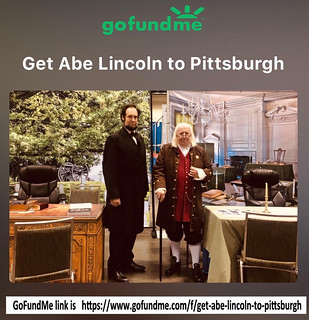 The Pennsylvania Association of Numismatists, in conjunction with PAN Secretary and Benjamin Franklin actor, Patrick McBride, have created an internet web based GoFundMe page to raise money
to bring renowned Abraham Lincoln actor, Dennis Boggs, to the American Numismatic Association's World's Fair of Money at the David Lawrence Convention Center, in Pittsburgh PA on August 4 – 8 2020.
The money generated will cover Dennis' fee, airfare, hotel stay, etc. McBride as Franklin lives in the Pittsburgh area and his presence carries a minimal cost.
The Pennsylvania Association of Numismatists, in conjunction with PAN Secretary and Benjamin Franklin actor, Patrick McBride, have created an internet web based GoFundMe page to raise money
to bring renowned Abraham Lincoln actor, Dennis Boggs, to the American Numismatic Association's World's Fair of Money at the David Lawrence Convention Center, in Pittsburgh PA on August 4 – 8 2020.
The money generated will cover Dennis' fee, airfare, hotel stay, etc. McBride as Franklin lives in the Pittsburgh area and his presence carries a minimal cost.
Lincoln and Franklin have appeared together previously charming young and old alike with their wit, humor and historical tales. Most recently they attended the Florida United Numismatists (FUN) convention in January of 2020 and the ANA World's Fair of Money, Chicago IL, in August of 2019. Many dealers, vendors, and attendees enjoyed posing for photos with these historical figures, but most importantly, the children whose eyes lit up and tongues tied in the presence of Mr. Lincoln or Dr. Franklin was priceless. Imagine being 10 years old and able to tell your teacher that you met President Lincoln or Dr. Franklin or BOTH! And what a more wonderful gift could we give our children than the desire to learn. Young collectors are the future of the coin business, and we encourage you make a donation.

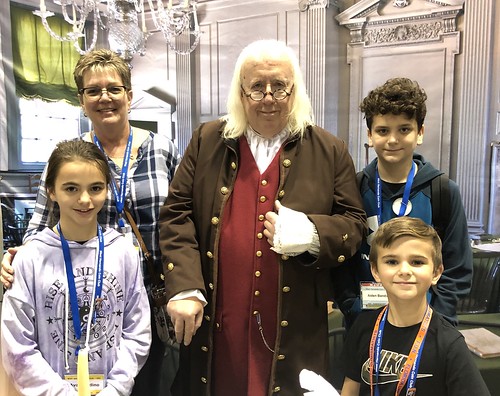
There is an added value with using Lincoln and Franklin as advertising to draw additional public the ANA-WFM Convention. Local print, television and radio media outlets will be notified.
Small amounts are encouraged. Ten dollars each from 400 donors will easily reach our goal. Please consider a $5 Lincoln note or a $100 Franklin note to get these engaging characters to Pittsburgh this summer. Mail donations are also gladly accepted. Make payable to:
PAN
1985 Lincoln Way
Suite 23 #225
White Oak PA 15131
The Internet web GoFundMe platform is popular and easy to use. All of the money raised goes to the stated cause with no processing fees. The platform will encourage donors to leave a tip that will
go to sustain the service. You are able to tip zero money if you choose or any dollar amount other than the recommended 10% the GoFundMe platform suggests. To donate go to:
https://www.gofundme.com/f/get-abe-lincoln-to-pittsburgh or to the PAN website home page www.PANcoins.org and click the photo.
For more information contact PAN Secretary Patrick McBride pancoins@gmail.com or 412-973-3525
Mr. Boggs is an amazing Lincoln portrayer, and a hard worker at numismatic events. A delight for visitors. I've made a donation - you can, too. -Editor
For more information, see:
www.MeetMrLincoln.com
www.FranklinAlive.com

SHARJAH MUSEUM OF ISLAMIC CIVILIZATION
Numismatourist Howard Berlin submitted this report of his recent visit to the coin collection in the Sharjah Museum of Islamic Civilization. Thanks! -Editor
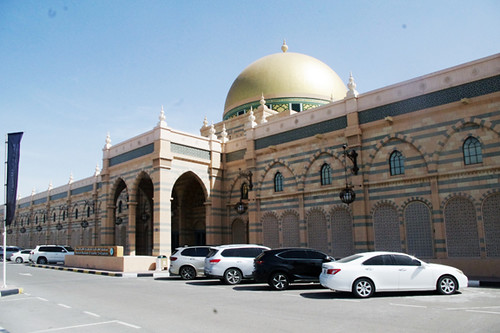
1. A view of the front entrance to the Sharjah Museum of Islamic Civilization.
A previous E-Sylum issue chronicled my visit to the Dubai Coins Museum. A few days later I took a taxi to the lesser known emirate of Sharjah which is the third largest of the seven UAE emirates, and is located about 45 minutes east of Dubai. My main purpose in traveling to Sharjah was to visit the coin collection on display at the Sharjah Museum of Islamic Civilization but I also wanted to get a broad overview of Sharjah while on hop on hop off tour bus.
There are a few things interesting about traveling to Sharjah from Dubai by taxi. There is a chain link fence at the border of the two emirates (can you think of anywhere else there is a border fence?). If you want the taxi to continue across the border, it costs an additional 25 dirhams ($6.81) just for that. However, there is a small opening in the fence and the taxi will drop you off there just on the Dubai side of the border fence and you then walk across. It's like walking across the border from the US to Mexico or from Spain to Gibraltar, etc. The Sahara Center shopping mall, where I needed to go to catch a hop on hop off tour bus, is just on the Sharjah side of the fence. So, with my bad knees and lower back, I hobbled across the border, saving 25 dirhams but I'm not sure it was worth the price for the pain. Although most taxis in Dubai take credit cards, but in Sharjah taxis are not allowed to take credit cards.
The current museum building was opened to the public on June 6, 2008 which replaced one that opened in 1996. It is located on Cornish Street in Sharjah's Al Nabba neighborhood and overlooks the waters of the Persian Gulf with Iran in the far distance.
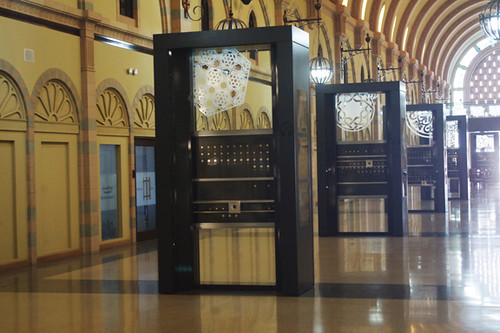
2. Seven free-standing displays contain over 250 coins.

3. A magnifying lens with a light can be positioned to view a more detailed image of any coin.
The museum's early Islamic coin collection is displayed in the atrium outside the Al Majarrah Gallery. Seven free-standing displays and several computer touch screens provide additional numismatic information about the collection. There are more than 250 coins on display and the text material on the sides of the displays provide information about the following topics:
- Islamic Coins
- Early Coins
- Coins of the Umayyad Era
- Abbasid coins
- Minting and Authority
- Inscriptions on Coins
- Coins, Power, and Prestige
- Coins as Historical Records
- Coin Design
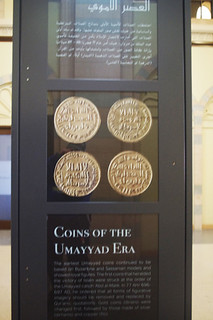
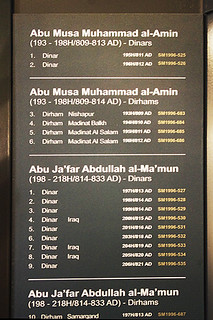
4. The sides of each display provides information about the coins for that display.
5. Each display lists a summary of all coins in Arabic on one side and English on the other.
Starting with the dinars of Abdul Malik bin Marwan (65-86 H/685-705 AD), the coins continue through those of Olcsytu Hudabende Muhammad Khan (703-726 H/1304-1316 AD). All text material is bilingual – in Arabic and English.
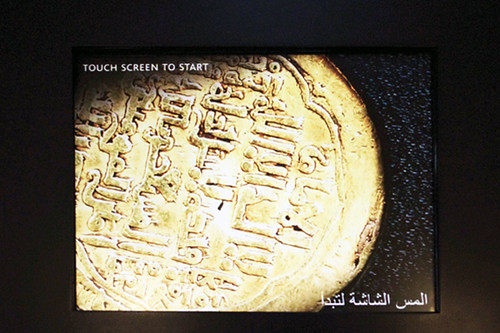
6. Touch-screen displays provide additional information about the coins in the collection.
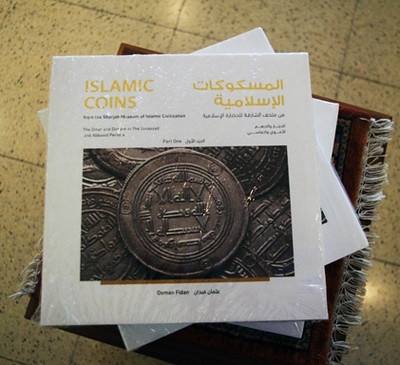
7. Front cover of the book, Islamic Coins, which is for sale in the museum's gift shop.
There is a gift shop where the book, Islamic Coins by Osman Fidan is for sale. Its price is AED 131.25 ($35.74). The museum is open Saturday to Thursday from 8:00 AM got 8:00 PM, and on Friday 4pm-8pm. Entry fees are AED 5.00 ($1.36) for children (2-12 years) and AED 10.00 ($2.72) for adults 13 years old and up.
At various points in life I've had both minor and more severe knee and back problems, all thankfully gone at this point. But having both issues together would lead me and likely most of us to stay close to home and closer to the couch. Not Howard, who continues his world travels nevertheless. Hooray for Howard! Thanks for these great reports! -Editor
To read the earlier E-Sylum article, see:
THE DUBAI COINS MUSEUM (https://www.coinbooks.org/v23/esylum_v23n08a23.html)
MUSEUM OF INDIAN PAPER MONEY
Here's an article from The Times of India about a new paper money museum. -Editor
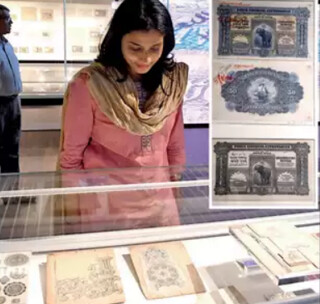 From a pre-Independence era currency note with a message for the British to ‘Quit India', to a much recent political message, ‘Jai Telangana', scribbled on a demonetised Rs 1,000 note, a
new museum in the city houses them all.
From a pre-Independence era currency note with a message for the British to ‘Quit India', to a much recent political message, ‘Jai Telangana', scribbled on a demonetised Rs 1,000 note, a
new museum in the city houses them all.
Businessman Rezwan Razack on Saturday unveiled the Museum of Indian Paper Money at Prestige Falcon Towers on Brunton Road. This is the second such museum in the country; the first was established by RBI in Mumbai.
Filled with paper notes that evolved in the country even before the British Rule, the museum has over 700 artefacts collected over a span of 20 years. It also houses artefacts contributed by several numismatists.
The museum was conceptualised three years ago, and a team worked to ensure it matched international standards. It has a special lighting system and data-logging facility in each of the exhibit sections. The exhibits are placed in a temperature and humidity-controlled environment to make sure the paper does not wither.
"If we ask our elders for an old coin, they can easily produce one. But not a currency note, which is tougher to maintain. This museum ensures that history is preserved through paper notes. Visitors will get to witness how the country changed through the years," Razack told reporters.
Curated in chronological order, the currency includes early notes of private and presidency banks, uniface notes of Colonial India, portrait notes of British monarchs and the recently released ones. One of the oldest notes is from 1812 and another is a high-denomination note of Rs 10,000. Razack said, "Every note tells a story. One was given to me by a Portugal man who contacted me through email. It took me over six months to get it."
A Hyderabad Rs 10 note which was lost in a shipwreck in 1932 and was salvaged later was the cynosure of all eyes on Saturday. It is autographed by the team of rescuers belonging to an Italian vessel.
Bazil Shaikh, author and former RBI secretary, said the museum is comprehensive when it comes to documentation and research. The museum will have orientation panels for kids and a souvenir shop; it will have an online presence. Entry fee is Rs 100.
SLICES OF HISTORY: The oldest currency note on display at the Museum of Indian Paper Money is from 1812; Rs 50 and Rs 500 notes issued by Portugal in Goa in 1924
To read the complete article, see:
South India's first currency museum opens in Bengaluru
(https://timesofindia.indiatimes.com/city/bengaluru/south-indias-first-currency-museum-opens-in-bengaluru/articleshow/74156948.cms)

MORE ALBRIGHTON HOARD COINS FOUND
Here's the first of three items on treasure coins passed along by Arthur Shippee from The Explorator newsletter. Thanks. -Editor
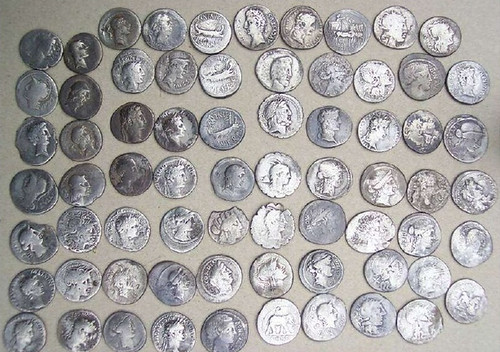
A collection of Roman coins has been declared treasure after being discovered at the site of a previous coin hoard.
The Albrighton Hoard, as it became known, was declared treasure in 2005, and the 69 denarii coins were acquired by Bridgnorth Museum.
Now, 15 years on, an extra 17 coins found at the same location have been confirmed to be treasure too after a coroner agreed they formed part of the same hoard.
Dating back more than 2,000 years, the coins were uncovered by a group of metal detectorists between March 2017 and October 2018.
Peter Reavill, Shropshire finds liaison officer for the British Museum's Portable Antiquities Scheme, told an inquest at Shirehall that the newly discovered coins were found "in the same general area as the original hoard".
Mr Reavill said the coins were "good quality", varied in denomination, and dated between 109 BC and 31 BC.
They were discovered alongside seven copper coins, which post-dated the silver and which were not regarded as treasure.
The coins will now be valued by a committee at the British Museum, after which Bridgnorth Museum will have the opportunity to buy them. The reward will be split between the finders and the landowner.
To read the complete article, see:
Roman coin hoard declared treasure
(https://www.shropshirestar.com/news/local-hubs/telford/albrighton-and-cosford/2020/02/28/roman-coin-hoard-declared-treasure/)
GOLD COINS FOUND AT AT JAMBUKESWARAR TEMPLE
Here's the second of three items passed along by Arthur Shippee. Thanks. Found via The Explorator newsletter. -Editor
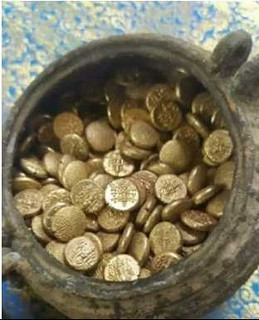 505 Gold coins found during renovation work at Jambukeswarar Temple in Tamil Nadu
505 Gold coins found during renovation work at Jambukeswarar Temple in Tamil Nadu
The pot was found by workers engaged in renovation work near the Akhilandeswari shrine in the temple complex. The temple is believed to have been constructed in the early Chola period, almost 1800 years ago.
The Jambukeswarar temple in Thiruvanaikovil, Tamil Nadu struck gold when 505 gold coins weighing 1.716 kg were found in a sealed vessel during digging.
As per officials, the coins were in a sealed pot that was spotted by workers near the Akhilandeshwari Shrine. When the temple officials opened it they found 505 gold coins. The coins are yet to be examined by the archaeologists to understand their age and history. As per reports, the pot was found at a depth of almost 7 feet.
According to sources, the temple, considered to be over a 1000 years old, was undergoing a renovation process in a periodic manner.
To read the complete article, see:
505 Gold coins found during renovation work at Jambukeswarar Temple in Tamil Nadu
(https://www.opindia.com/2020/02/tamilnadu-jambukeswara-temple-gold-coins-pot-hr-ce-archeology-treasure/)

NEW TREASURE COAST SILVER COIN FIND
Here's the last of three items passed along by Arthur Shippee. Thanks. Found via The Explorator newsletter. -Editor
 Jonah Martinez, 43, a treasure hunter from Port St. Lucie, was scanning the sand with his metal detector at Turtle Trail Beach Access on Feb. 21 when his device picked up a signal.
Jonah Martinez, 43, a treasure hunter from Port St. Lucie, was scanning the sand with his metal detector at Turtle Trail Beach Access on Feb. 21 when his device picked up a signal.
Buried beneath him was more than three centuries of history:
Martinez pulled 22 Spanish silver coins from the surf, each dating back to a shipwreck 305 years ago, he said.
Twelve Spanish galleons laden with treasures from the New World were bound for Spain on July 31, 1715, but 11 were lost during a hurricane off the coast of Florida. Most of the treasure lies beneath the ocean.
"Not everyone knows why it's called the Treasure Coast," Martinez said. "This is why."
To read the complete article, see:
Treasure hunter unearths silver coins from 300-year-old Spanish
shipwreck on Florida beach (https://www.usatoday.com/story/news/nation/2020/02/28/spanish-coins-1715-shipwreck-unearthed-florida-beach/4902578002/)
THE 'RICHMOND DOLLARS'
This week I was part of an email exchange kicked off by Dave Bowers. -Editor
The August 1915 issue of The Numismatist included this:
"Enormous quantities of siege and battlefield money, both notes and coins, were turned out by the Confederates during the American Civil War which broke out in 1861 over the question of slavery. The notes, of which many thousands are still in existence, are now worth little or nothing, save as curiosities; but some of the pieces of coined money are highly valued by collectors.
"This is especially the case as regards the ‘Richmond dollars,' which were minted inside the town during its long siege by the forces of General Grant, and which are really very handsome coins. It is currently said, by the way, that the dies for these dollars were cut by a couple of Londoners who had enlisted in the Confederate army, and who had originally been compelled to leave their native London in a hurry because of the misapplied enterprise they had shown there in making money at their own private ‘mints.'"
I'd never heard of 'Richmond Dollars', and didn't believe this story. No one was using coins during the war. I wondered if this could be referring to circulating counterfeits made after the war. -Editor
Dave Schenkman writes:
"I know nothing about them either, but tend to agree with you. I read the 1915 article, and it just doesn't make sense to me."
Confederate Numismatica author Peter Bertram writes:
"Richmond dollars? Really? Never heard of such a thing and view any claims about 'em as pure bologna!
"If one wishes to pull a scam, at least start with a verifiable fact or two. This scam is dead right out of the gate since there was no siege of Richmond, long or short. Grant's "long siege" was vs Vicksburg, Mississippi and there were no dollar coins struck there either!
"I don't think I'd invest too much time or effort (and no $$) looking for a specimen of such a coin since I doubt they exist."
Peter found this follow-up in the December 1918 Numismatist. -Editor
"The August, 1915, issue of The Numismatist contained an article, "Money Coined on the Battlefield," credited to Pearson's Weekly. Included in the issues of money coined under those circumstances was the Richmond Dollar", said to have been struck in the Virginia Capital during its long siege by General Grant during the Civil War. Until the publication of this article collectors generally had been blissfully ignorant of the existence of such a coin. The past month brought us a clipping from one of our readers, credited to Answers of London, which apparently was rewritten from the former article referred to. The paragraph in Answers relating to the "Richmond dollar" is as follows:
"During the American Civil War of 1861 a tremendous amount of battlefield money was turned out, both metal coin and notes. There are thousands of the latter still in existence, but as a means of exchange and bart they are of no value, except when regarded as curios. On the other hand, collectors of foreign and ancient coins set great store by the metal money which was made on the battlefield at that time. Perhaps the handsomest of all coins are those called the "Richmond dollars. " They were made during that long siege in which General Grant used his strong forces to such purpose. A couple of Britishers who were forced to escape from London about the time of this war, owing to their skill being utilized in their native town in a manner which brought them within the reach of the law, had enlisted with the Confederates, and it was they who cut the dies for this very handsome Richmond dollar. "
Collectors are well aware that frequently new varieties of coins come to light after many years, but it is seldom that the entire issue of a coinage can be successfully concealed from the great body of American collectors for any great length of time. These magazine writers convey the impression that the "Richmond dollars" are well known to collectors and that specimens of it are to be found in many of their cabinets.
After reading the above, with the knowledge collectors have of the money issued during the Civil War, they will be forced to conclude one of the four following things, probably the last:
First - That the "Richmond dollar" is a reality, and that a specimen had been seen by the writer.
Second — That he had heard of the Confederate half dollar, and in his mind has transferred the mint from New Orleans to Richmond.
Third — That he has mistaken some medal issued at the time, or for the occasion, for a "Richmond dollar. "
Fourth - That he never saw or otherwise heard of a "Richmond dollar", and drew entirely upon his imagination for the story."
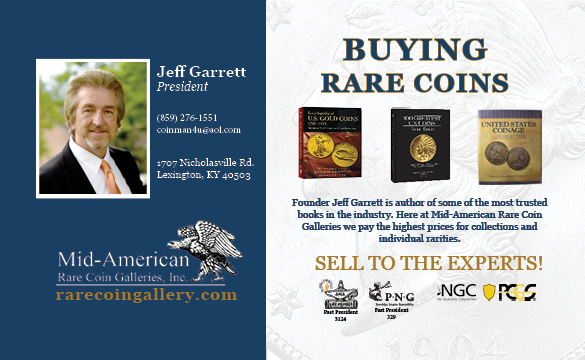
THE CHAPMAN PROOF 1921 MORGAN DOLLAR
Stack's Bowers Senior Numismatist James McCartney published a blog article this week about the Chapman Proof 1921 Morgan dollar. A specimen is offered in the firm's March 2020 Baltimore auction at the Whitman Coin & Collectibles Spring Expo. -Editor
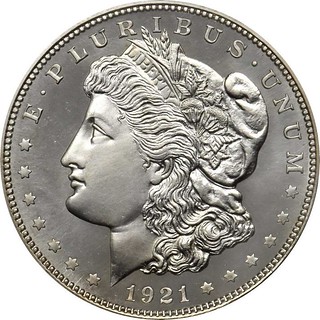
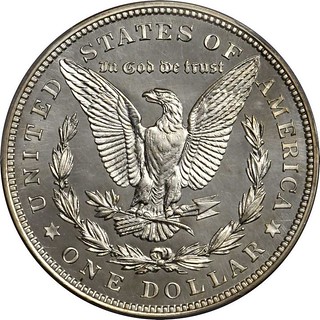
The Chapman Proof 1921 Morgan dollar is among the most elusive issues of the entire series, far exceeding in rarity the legendary Proof-only 1895. We are thrilled to offer one of very finest survivors from this clandestine issue in lot 3210 of our March 2020 Baltimore Auction. Certified Proof-67 (PCGS), it is the sole finest example on the PCGS Population Report and is numerically tied with just the Proof-67 * (NGC) example from the Duke Collection.
As an unofficial U.S. Mint issue, more mystery than fact is involved in its creation--in fact, the only items that we can be sure of is that these were produced by George T. Morgan at the behest of prominent Philadelphia coin dealer Henry Chapman. Dave Bowers sums up the situation best in his Silver Dollars and Trade Dollars of the United States: A Complete Encyclopedia:
"In 1921, Henry Chapman went to the Mint and had some mirror-surface Proofs struck to his order. This was done clandestinely by or for George T. Morgan, chief engraver, who had a little 'rare coin business' going on the side. Walter H. Breen reported that he has seen 'the bill of sale for 10 Proofs, Morgan to Chapman.' The original production of mirror-type Proofs must have been very small, perhaps just 15 in all (10 to Chapman, 5 to Ambrose Swasey)... They were not officially sold by the Mint, nor were any Proof sets made that year."
The Chapman Proofs are the only pieces considered to be fully mirrored Proofs; the so-called "Zerbe Proofs" are either prooflike business strikes or some sort of presentation striking. PCGS lists the Chapman Proofs with the regular Proof issues, while categorizing the "Zerbe Proofs" as Special Strikes. Though rendered difficult to see from the toning gained through five or more decades of paper envelope storage, this specimen exhibits the tiny die scratches and other markers that identify the Chapman Proofs at the microscopic level -- diagnostics outlined in the Bowers Encyclopedia.
To read the complete article, see:
Superb Gem 1921 Chapman Proof Morgan Dollar Featured in our March 2020 Baltimore Auction.
(https://www.stacksbowers.com/News/Pages/Blogs.aspx?ArticleID=proof-morgan-silver-dollar-chapman)
To read the complete lot description, see:
1921 Morgan Silver Dollar. Chapman. Proof-67 (PCGS).
(https://auctions.stacksbowers.com/lots/view/3-LWW05/1921-morgan-silver-dollar-chapman-proof-67-pcgs)

DWIGHT MANLEY ACQUIRES BULK OF BAKER COLLECTION
The Philadelphia Inquirer reporter who wrote about the Historical Society of Pennsylvania's sale of the Baker collection of Washingtoniana wrote this week about the new owner of the bulk of the collection - Dwight Manley. -Editor
There was a moment, early on during the Nov. 16 auction, when anonymous internet bidder 3975 had a kind of epiphany.
 He was acquiring medal after medal, each from the legendary collection of William Spohn Baker, all being sold at a Baltimore auction on behalf of the Historical Society of Pennsylvania.
Baker, who died in 1897 at his Arch Street home, had directed his collection be held by HSP in perpetuity, but HSP decided perpetuity had its limits — 122 years, to be exact, from the time of their
donation to the time they were boxed and sent out of town last year, with prior approval from both the Attorney General's Office and Orphans Court.
He was acquiring medal after medal, each from the legendary collection of William Spohn Baker, all being sold at a Baltimore auction on behalf of the Historical Society of Pennsylvania.
Baker, who died in 1897 at his Arch Street home, had directed his collection be held by HSP in perpetuity, but HSP decided perpetuity had its limits — 122 years, to be exact, from the time of their
donation to the time they were boxed and sent out of town last year, with prior approval from both the Attorney General's Office and Orphans Court.
Bidder 3975 didn't know about that, he said. What he did know was that this was a once-in-a-lifetime opportunity to buy one of the great numismatic collections in the nation, a collection painstakingly gathered over decades by Baker, a writer and collector of books, documents, prints, and coins and medals, all associated in some way with George Washington. (The books and documents remain at HSP.)
The medals, being auctioned in 1,102 individual lots, were the prize for bidder 3975.
"I was shocked that such a historical and unique collection would be sold off," he said. "I went into it thinking I'm just going to pick up a few pieces. But I realized the opportunity is there to keep [the collection] intact."
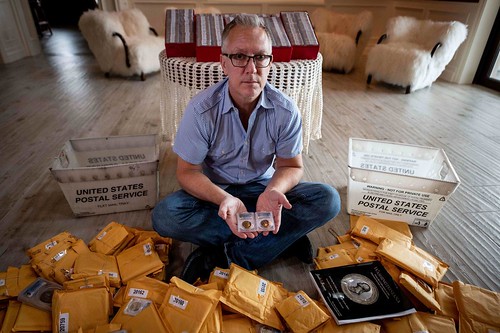
So it was that Dwight Manley, 54, a California coin collector since he was a kid, the man who rescued the career of bad-boy basketball player Dennis Rodman and made him rich again, came to what may be his biggest achievement yet.
"I bought 85 percent of the lots," Manley said. "Some I didn't buy because I already had the medals. Some I bought after the auction from other buyers. I bought over 850 individual lots."
Now Manley plans to make the collection accessible to the public. An exhibition is already in the works for the spring of 2021 at the Money Museum at the Colorado Springs digs of the American Numismatic Association.
"I want to give people the opportunity to see the collection and to use it for research," Manley said. "I want people to know that the collection is mostly intact and that it will be available for scholars and the public."
The museum will hold the medals on loan, incorporating them into its educational programs, according to Douglas Mudd, Money Museum curator and director.
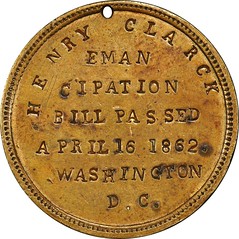 Mudd called the collection "amazing."
Mudd called the collection "amazing."
"Ultimately the [Baker Collection medals] should be on display in Washington or Pennsylvania or some place," said Manley. "These aren't all round, shiny things. They all ... each piece, has a story."
To read the complete article, see:
Dennis Rodman's ex-agent bought the Pa.
Historical Society's prized Baker Collection medals at auction. He's going to exhibit them
(https://www.inquirer.com/arts/dennis-rodman-former-agent-dwight-manley-buyer-philadelphia-pa-historical-society-baker-collection-medals-20200228.html)
To read the earlier E-Sylum article, see:
THE SELLING OF THE BAKER COLLECTION (https://www.coinbooks.org/v23/esylum_v23n08a30.html)
DIX NOONAN WEBB IRISH BANKNOTE SALE
This press release describes Dix Noonan Webb's first-ever sale of Irish banknotes. -Editor
 A unique and fascinating collection of archive material from the Allied Irish Bank (formerly the First Trust Bank) will be offered for sale in the first auction devoted to Irish Banknotes
at Dix Noonan Webb, the international coins, medals, banknotes and jewellery specialists, on Thursday, March 12, 2020 at 1pm at their auction rooms in central Mayfair - 16 Bolton St, London,
W1J 8BQ. The proceeds from this sale of 120 lots will be spilt between Age Northern Ireland and the Alzheimer's Society.
A unique and fascinating collection of archive material from the Allied Irish Bank (formerly the First Trust Bank) will be offered for sale in the first auction devoted to Irish Banknotes
at Dix Noonan Webb, the international coins, medals, banknotes and jewellery specialists, on Thursday, March 12, 2020 at 1pm at their auction rooms in central Mayfair - 16 Bolton St, London,
W1J 8BQ. The proceeds from this sale of 120 lots will be spilt between Age Northern Ireland and the Alzheimer's Society.
The rare and large collection of Proofs, Specimens and high grade issued notes from the Provincial Bank, Allied Irish Bank and First Trust Bank. The material has been split into three sections, each of which will be offered in a separate auction and includes many examples that haven't been offered to the market before.
Adrian Moynihan, Head of AIB (NI) said: "With a long and proud history of supporting the Northern Ireland community, AIB is delighted to bring forward for auction its banknote archive in the hope and anticipation that it will raise significant money for two local charities."
Thomasina Smith, Specialist at Dix Noonan Webb, commented: "We are very excited to offer this collection, which offers a great insight into the printing process and evolution of the Bank's paper money before it ceased issuing in 2019."
Among the notable items are four uncut sheets of 35 First Trust Bank £10 proofs from the 1994-96 issue which are estimated at £2,000-£2,600, while three uncut sheets of 24 First Trust Bank £100 dating from 1 March 1996 carry an estimate of £1,500-£2,000.

The sale also includes 200 lots of Irish Banknotes from various vendors, these include a rare and attractive high denomination Bank of Ireland £20, dating from 10 November 1915, which is expected to fetch £3,000- £3,600.
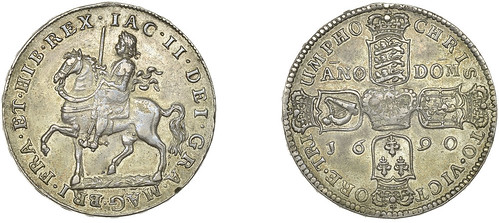
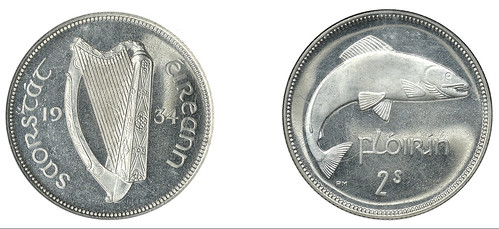
The sale will be preceded on March 11 by a sale of Irish Coins and Medals which includes an extremely rare Free State (1921-1937) Proof Florin dating from 1934. Only one other specimen is believed known and this example is estimated at £8,000-£10,000; while a very fine and extremely rare silver Proof Crown dating from 1690, and the reign of James II (1685-1691) carries an estimate of £6,000-£8,000.
To visit the Dix Noopn Webb website, see:
https://www.dnw.co.uk/
THE BOOK BAZARRE
HIDDEN WORDS IN SEYCHELLES BANKNOTE DESIGNS
This article published last week by PMG discusses words found hidden in Seychelles banknotes. -Editor


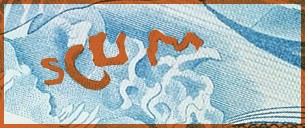
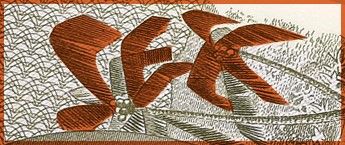
Paper Money Guaranty (PMG) has discovered a mischievous word hidden in the design of the 1968, 1971 and 1974 series of Seychelles 20 Rupees.
Seychelles notes from this era are known to contain coarse language hidden in their designs. On the 1968 and 1974 10 Rupees, the word SCUM can be seen at the bottom-left below the turtle.
A PMG grader discovered that the word POOP can be found on the front of the 1968, 1971 and 1974 20 Rupees, hidden in the branches in front of the bird's tail feathers. The identification was confirmed by PMG's senior graders.
Seychelles is an archipelago in the Indian Ocean several hundred miles northeast of Madagascar. The words are believed to have been hidden in the designs by someone who supported Seychelles' bid for independence from the United Kingdom, which was granted in 1976.
Seychelles also issued 5 Rupees and 100 Rupees notes during this era, but to date no hidden words have been found on these notes. Such a discovery may still await a sharp-eyed numismatist.
The idea that messages can be hidden in plain sight in something as commonly used as banknotes sparks imaginations far beyond the field of numismatics. For instance, currency issued in Japanese-occupied China in the late 1930s and early 1940s sometimes included subversive messages that were widely understood, including an image of Confucius making an obscene gesture.
The "Vampire Notes" issued in Germany in the 1920s have a vampire hidden in the neck of the man featured on the front of the note. This reflected the sentiment that France was sucking the life of out Germany, which was severely affected by postwar hyperinflation.
To read the complete article, see:
PMG Discovers Hidden Word in Seychelles Banknote Design
(https://www.pmgnotes.com/news/article/8126/pmg-attributing-seychelles-hidden-text/)
MEXICO PLANS NEW 50-PESO BANKNOTE
Mexico News Daily reported on an upcoming new banknote. -Editor
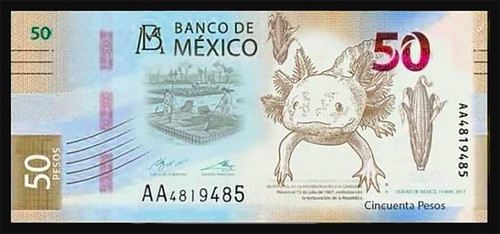
An unofficial replica of the new 50-peso banknote that has surfaced on social media.
The axolotl, a species of salamander endemic to Mexico City's Lake Xochimilco, may be endangered but it recently got some news that could give it something to smile about.
The Bank of México (Banxico) announced that the amphibian will grace the new series of 50-peso notes to be put into circulation in 2022.
Accompanying the grinning creature will be an ear of corn and an image of farmers tending crops on the famous chinampas, or manmade islands used for agriculture.
The axolotl, a species of salamander endemic to Mexico City's Lake Xochimilco, may be endangered but it recently got some news that could give it something to smile about.
The Bank of México (Banxico) announced that the amphibian will grace the new series of 50-peso notes to be put into circulation in 2022.
Accompanying the grinning creature will be an ear of corn and an image of farmers tending crops on the famous chinampas, or manmade islands used for agriculture.
The new family of bills will soon lose a member, as Banxico is planning to gradually take the 20-peso note out of circulation and replace it with a coin. It will both commemorate Mexican independence and enshrine the crocodiles and mangrove forests of the Sian Ka'an Biosphere Reserve in Quintana Roo.
To read the complete article, see:
Xochimilco's endemic axolotl to appear on new 50-peso bill
(https://mexiconewsdaily.com/news/axolotl-to-appear-on-new-50-peso-bill/)

COLOR-CHANGING CRYSTAL VS. COUNTERFEITING
This article from Chemistry World describes a discovery that could lead to a new anti-counterfeiting measure for banknotes. -Editor
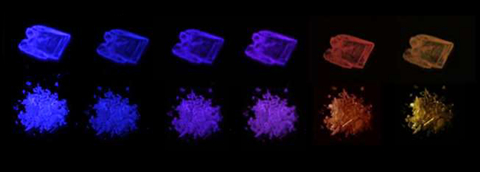
A crystal that glows blue but changes colour to purple and then orange within a second could make banknotes more resistant to counterfeiting.
Fluorescence and phosphorescence – a type of delayed fluorescence – make materials glow a single colour. Now, a team of chemists in China has discovered the first single compound that has a colour-changing afterglow. Currently, to get a similar effect, researchers needed to build materials out of several different phosphorescent molecules.
The molecule in question is 4,4'-bis(N-carbazolyl)-1,1'-biphenyl (CBP), a symmetric, linear aromatic. Under ultraviolet light, it is faint blue in colour. But after the UV light is switched off, it glows blue, changing to purple and then orange before fading.
In combination with a diphenylanthracene derivative, CBP might make for more secure anti-counterfeiting marks on bank notes and other items that need a security tag. Under UV light, one set of symbols is visible as the anthracene interferes with CBP's fluorescence. When the UV light is switched off, the anthracene becomes inactive and CBP's afterglow shows off another, colour-changing set of symbols.
To read the complete article, see:
First colour-changing crystal glow could make for safer banknotes
(https://www.chemistryworld.com/news/first-colour-changing-crystal-glow-could-make-for-safer-banknotes/4011246.article)
CHINA'S BANKS DISINFECT OR DESTROY BANKNOTES
 China's central bank in Guangzhou announced it will destroy cash collected by hospitals, buses, and markets in coronavirus-afflicted areas to curb the outbreak's contagion,
financial news outlet Caixin reported Saturday.
China's central bank in Guangzhou announced it will destroy cash collected by hospitals, buses, and markets in coronavirus-afflicted areas to curb the outbreak's contagion,
financial news outlet Caixin reported Saturday.
The People's Bank of China ordered all paper currency with high exposure to the outbreak withdraw cash for either destruction or disinfection, according to Caixin. Commercial banks were told to place banknotes from infected areas aside, clean them, and hand them to the central bank.
The coronavirus continues to spread around the world and most heavily hit China's population. The outbreak is responsible for 1,670 deaths with nearly 70,000 infected as of Sunday afternoon. Coronavirus has already prompted economists to lower their expectations for global growth, and major corporations have warned that the drag on global supply chains will likely hit quarterly results.
The People's Bank of China will use high temperatures or ultraviolet light to disinfect bills and store the cash for more than 14 days before placing it back into circulation. Central banks around the world frequently destroy old notes to balance out the supply with new cash. The practice doesn't affect the money supply, though the coronavirus-related action is separate from such regular measures.
An unnamed deputy chief at a large bank in Guangzhou told Caixin that, while customers will be asked where their deposited cash is from, "it would be difficult for such a measure to be completely effective."
To read the complete article, see:
China will start destroying cash collected
in areas with high exposure to the coronavirus
(https://markets.businessinsider.com/news/stocks/china-peoples-bank-destroy-cash-coronavirus-affected-regions-outbreak-contagion-2020-2-1028908771)
VISITING THE MUTILATED CURRENCY DIVISION
We've covered this topic before, but it's always fun the have a fresh look. The Washington Post recently visited the Treasury Department's Mutilated Currency Division. Here's an excerpt, but see the complete article and more images online. -Editor

Gao E. Freeman presses a piece of tape into a clump of material that looks like the gunk you might find on the bottom of your boot after a muddy hike. With a scalpel, he carefully loosens and lifts a thin layer and attaches it to a pale blue index card. He repeats this process four times. In minutes, he has enough evidence to identify the fragments as five $20 bills. The amount is a mere drop in a bucket — or, in this case, a plastic bag — that may have contained $150,000. But it's a promising drop nonetheless.
Freeman is one of a dozen examiners with the Mutilated Currency Division of the Treasury Department's Bureau of Engraving and Printing. These experts play forensic scientist with damaged bank notes; you might call it "CSI: Currency Victims Unit." They inspect an owner's unusable money to determine a value, which the Treasury Department will redeem in check form.
Every week, the federal office in Southwest Washington receives hundreds of padded envelopes, boxes and even safes stuffed with cash ravaged by water, fire, shredding machines, insects or a canine's teeth. "Your dog ate your money. Your grandma buried $100,000 in her backyard. Your 2-year-old shredded an envelope filled with $1,000," says program manager Ty Hensell. "Look it up on YouTube," he instructs, referring to the last scenario, a well-publicized event from October 2018.
The examiners, who worked on 23,600 cases in 2019, try to salvage as many bills as possible. The more they can piece together, the larger the reimbursement check. Last year, the agency issued checks for more than $35 million to businesses and individuals who had submitted their battered money, hoping to recoup some or all of its value. "We only redeem on what we can validate and authenticate," not what someone claims they lost, says Lydia Washington, lead public affairs specialist with the bureau.
Mutilated cash should be treated as if it were a body in a crime scene: Leave it as intact as possible, unless it has been exposed to a toxin or other impurities. "If it's got dog poo or blood on it, clean it off," says Washington. "Or let us know if it's been contaminated." (All the work stations come with environmental HVAC systems and protective gear including gloves, masks and goggles.)
This mid-January morning, nearly everyone on the floor has a tough case. Barbara Gray delves into a yellow shoe box that, according to the enclosed note, contained $600,000. The owner had buried the wad in a backyard in Argentina. "They thought it was a safe place," she says. It wasn't. After so much time underground, the stacks of cash resemble briquettes after a cookout. Gray uses a pair of scissors to excise the image of Benjamin Franklin from several bills. Six eyes gaze up at her. That's $300 so far.
To discourage fraudsters who might try to redeem the same notes twice, the office has safeguards: A bank note counts only if more than half of it is discernible (so don't try sending in the other 49 percent at a later date) or if it's in total ruins. The staff also attends training sessions led by the Secret Service to learn how to spot counterfeit currency. That's rare, but it happens.
On occasion, folks will receive payment for less than their estimate. Other times, the recipient will reap a windfall as unexpected as Ed McMahon showing up with a Publishers Clearing House check. Barnett, a 20-year employee, shares the bittersweet story of a son who, after his father died, discovered water-damaged money in the garage. He guessed it was $50,000; Barnett counted $400,000. And then there are the people who know the exact amount, down to the last zero. During the 2008 financial crisis, a Texas man hid $2 million in his garage. The first shipment contained a million dollars that had turned to mush, but the second million was only damp.
To read the complete article, see:
If your
cash gets damaged, this Treasury team will make sure it's not a lost cause
(https://www.washingtonpost.com/lifestyle/magazine/if-your-cash-gets-damaged-this-treasury-team-will-make-sure-its-not-a-lost-cause/2020/02/13/609fd154-3c6b-11ea-8872-5df698785a4e_story.html)
LOOSE CHANGE: MARCH 1, 2020
Here are some additional items in the media this week that may be of interest. -Editor
NFL 100 Challenge Coin
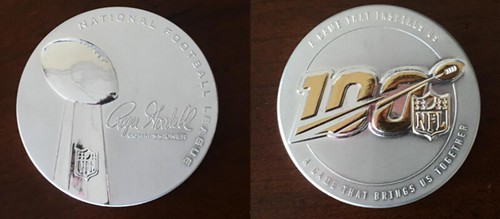
Sam Lombardo's Super Bowl LIV surprise didn't end with the final tick of the clock at Hard Rock Stadium on Feb. 2.
On Tuesday, Lombardo's mail included an elegant coin and a heartfelt letter from National Football League Commissioner Roger Goodell, memorializing the retired Army lieutenant colonel's participation in the coin toss for the contest between the San Francisco 49ers and the Kansas City Chiefs.
Lombardo was one of four 100-year-old World War II veterans chosen by the NFL to participate in the coin toss, to mark both the 75th anniversary of the end of that war, and the 100th year of the NFL.
The thick silver coin, though not the official coin used for the game-day coin toss, features the NFL logo for its 100th anniversary offset in gold on one side, and the Super Bowl trophy and Goodell's signature on the other side. Around the NFL logo are the words "A Game That Inspires Us. A Game That Brings Us Together."
To read the complete article, see:
Local veteran honored at Super Bowl gets another surprise
(https://www.nwfdailynews.com/news/20200219/local-veteran-honored-at-super-bowl-gets-another-surprise)
Aloha to Hawaiian Coinage
Michael Garofalo published a nice survey article about Hawaiian Coinage in the Greysheet daily news. Here's a short excerpt - see the complete article online for much more. -Editor
 The Keneta is roughly the same diameter as the Large Cent. The obverse bears a military bust of the king on the obverse, facing front, with the legend "KAMEHAMEHA III. KA MOI." around him
and the date "1847" below. The reverse has the denomination "HAPA HANERI" within a wreath, tied with a bow at bottom, surrounded by "AUPUNI HAWAII." There are two different obverse varieties—one with
a Plain 4 in the date, and the other has a Crosslet 4. There are also six separate varieties of reverse dies.
The Keneta is roughly the same diameter as the Large Cent. The obverse bears a military bust of the king on the obverse, facing front, with the legend "KAMEHAMEHA III. KA MOI." around him
and the date "1847" below. The reverse has the denomination "HAPA HANERI" within a wreath, tied with a bow at bottom, surrounded by "AUPUNI HAWAII." There are two different obverse varieties—one with
a Plain 4 in the date, and the other has a Crosslet 4. There are also six separate varieties of reverse dies.
It was agreed that 100,000 of these Keneta coins would be struck by H.M & E. I. Richards of Attleboro, MA. This company had struck a number of Hard Times tokens so they were respected private minters.
The coins left the port of Boston on the merchant ship S.S. Montreal. The journey would leave Boston, sailing south down the eastern coast of America, south past Central America and skirt the east coast of South America. The ship made a planned stop at Rio de Janeiro and then sailed south coming around the tip of South America at Tierra del Fuego. Now the Montreal headed north along the coast of South America and then at Santiago, Chile, headed due west across the Pacific to Tahiti. That was the last stop before docking in Honolulu. But after five months on board the humid and wet ship, many of the copper coins were badly discolored.
But that was not the worst discovery. The King's portrait was very disappointing as he was unrecognizable to his subjects. This certainly set these coins off on the wrong trajectory. It took a number of years before even a small number of the 100,000 coins were disbursed. More than 88,305 coins were eventually shipped out of Hawaii and scrapped. The Keneta experiment was not a rousing success then but today the coins are considered scarce and are valuable.
To read the complete article, see:
Aloha to Hawaiian Coinage (https://www.greysheet.com/news/story?title=aloha-to-hawaiian-coinage)
Paying for one criminal activity with another
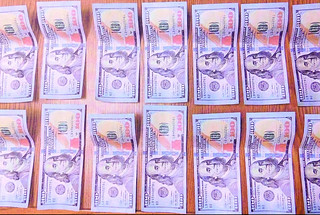 A suspected counterfeiter was arrested last week after a prostitute took exception to being paid with phony money.
A suspected counterfeiter was arrested last week after a prostitute took exception to being paid with phony money.
Now the Belmont County Sheriff's Department is asking residents to report any suspicious currency they receive.
According to Sheriff David Lucas, his office received a complaint Thursday that a female prostitute was paid with counterfeit money and then assaulted after objecting to the payment being made with fake bills.
"It was at a local motel," Lucas said, "trying to pay someone (for) one criminal activity with another criminal activity."
To read the complete article, see:
Counterfeit Franklins failed to fund illegal tryst
(https://www.timesleaderonline.com/news/local-news/2020/02/counterfeit-franklins-failed-to-fund-illegal-tryst/)
Long-hidden Passageway Uncovered in Parliament
It's not numismatic, but interesting and fun nonetheless. If you haven't seen this story already, check out the long-hidden passageway uncovered in Parliament. -Editor

A forgotten passageway used by prime ministers and political luminaries - and closed up by Victorian labourers - has been uncovered in Parliament.
Historians working on the renovation of the House of Commons found the lost 360-year-old passageway, hidden in a secret chamber.
The doorway was created for the coronation of Charles II, in 1660, to allow guests access to a celebratory banquet in Westminster Hall, the building next to the modern day Commons chamber.
It was used by generations of MPs and political notables, such as the diarist Samuel Pepys, as the main entrance to the Commons but was blocked up before being concealed within the thick walls of the ancient building.
Dendrochronology testing revealed that the ceiling timbers above the little room dated from trees felled in 1659 - which tied in with surviving accounts that stated the doorway was made in 1660-61 for the coronation banquet of Charles II.
To read the complete article, see:
Secret doorway in Parliament leads to historical treasure trove (https://www.bbc.com/news/uk-politics-51630630)

